Tasmania is a unique part of Australia, full of natural beauty, with a significant chunk of the state designated as national parks and certain wildlife only found here. No Hobart itinerary would be complete without at least some natural beauty and a Tasmanian Devil!
Tasmania is also home to significant parts of early and modern Australian history that have shaped the country, like Port Arthur, a historic convict settlement with a notorious history and the site of the infamous 1996 Port Arthur massacre.
Similar convict-era sites can be found all around Hobart and elsewhere in Tasmania. Your Hobart itinerary will probably include at least some of them.
Getting to Hobart
Hobart is the capital city of the state of Tasmania, an island state south of Victoria. Since it is separated from the rest of the country by the Bass Strait, the easiest way to get there is to fly.
For a different experience, you can also take the Spirit of Tasmania, a ferry, from Geelong in Victoria to Devonport in Tasmania, with or without a vehicle.
If you take the ferry, it is an 11-hour, 15-minute trip followed by a 255 km drive to Hobart.
There are Europcar y Budget car rental depots located at the ferry terminal in Devonport.
Getting around Hobart
Hobart has limited public transport, with busses operated by MetroTas across the greater Hobart region.
Being smaller than every other capital city in Australia, except for Darwin, Hobart is easily managed by car, with many of the key historic sights located within walking distance around the Hobart CBD.
There are hop-on hop-off busses and shuttle buses that include both the CBD hop-on hop-off bus but also options that go to Richmond Village and Mt Wellington summit.
Pre-Book Your Hobart Bus Tour Tickets Online:
- CBD Red Decker Hop-On Hop-Off Bus:
- Richmond Village
- Mt Wellington Summit
MetroTas busses will also connect you to many of the sights further from the city centre, but to see the iconic sights outside of Hobart (like Port Arthur and Freycinet National Park), you will need to rent a car, take one of the shuttle busses above, or take an organised tour.
Most coche de alquiler companies have depots near the city centre. Avis/Budget and Hertz are the most convenient to the CBD. Sixt and Red Spot/Enterprise are also close by. Europcar is a little further out.
I recommend Avis y Europcar. Check out AutoEurope to compare prices with other providers and also make sure to check out current rental deals for booking direct:
For the driving on this itinerary, you don’t need a 4WD or anything fancy, just whatever vehicle is comfortable for you, but be sure to book in advance to get the best pricing and widest choice. It will also save you a lot of time on the day! Speaking of saving money, you might also be interested in this article I wrote about saving money on fuel in Australia.
Once you have your car, whip out your GPS/phone, and we’re off.
I usually take a MagSafe car vent mount with me on our trips to easily mount my iPhone for directions and charging. I’ve currently got this one which I love.
Where to stay in Hobart
There are many convenient options around Hobart, but I would suggest staying in the CBD, in the area around Constitution Dock, to make the most of the historic city sights.
We have stayed at Zero Davey Boutique Apartments beside Victoria Dock, and while it isn’t the cheapest place to stay, it is very comfortable and conveniently located – I highly recommend them. Plus if you do take the hop-on hop-off bus, one of the stops is right outside!
Zero Davey Boutique Apartments Links:
- Hotel Website
- Opiniones de TripAdvisor
- Book on Booking.com
- Book on Agoda
- Book on Expedia
- Book on Trip.com
Notes on attraction availbility in this Hobart Itinerary
Some of the attractions in this itinerary are only open on certain days, eg MONA and Salamanca Market, so it is worth keeping that in mind as you plan your trip if these are things you want to do.
Days 1 and 2 from this itinerary cover some of the same areas North East of Hobart and can be easily mixed and matched based on the days that MONA is open and how long you will spend at some of these attractions (not everyone will spend the amount of time at MONA that we did).
Just make sure that however you arrange it, you leave yourself enough time for Port Arthur, the Tasman Peninsula, and Freycinet National Park.
Day 1 – Tasmanian Devils & Port Arthur
Day 1 in Hobart, and we will meet the iconic and elusive Tasmanian Devil before heading to the Tasman Peninsula to visit the infamous Port Arthur historic site and Devils Kitchen.
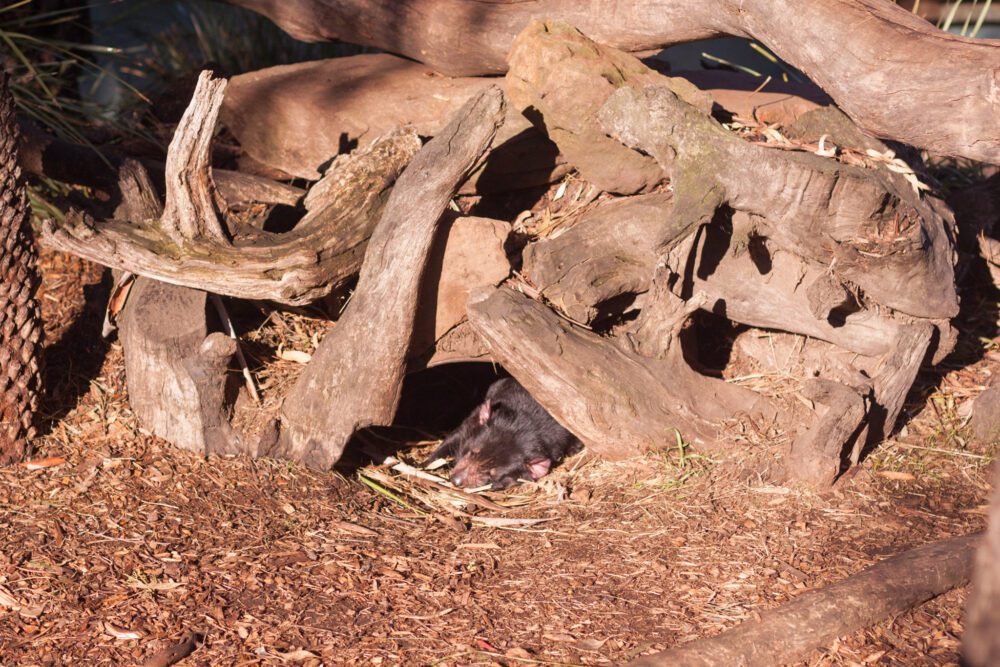
Bonorong Wildlife Sanctuary
We jumped in the coche de alquiler we picked up at Hobart Airport the night before and headed north to Bonorong. Depending on traffic, it’s about a 30-minute drive from Hobart CBD to the Bonorong Wildlife Sanctuary.
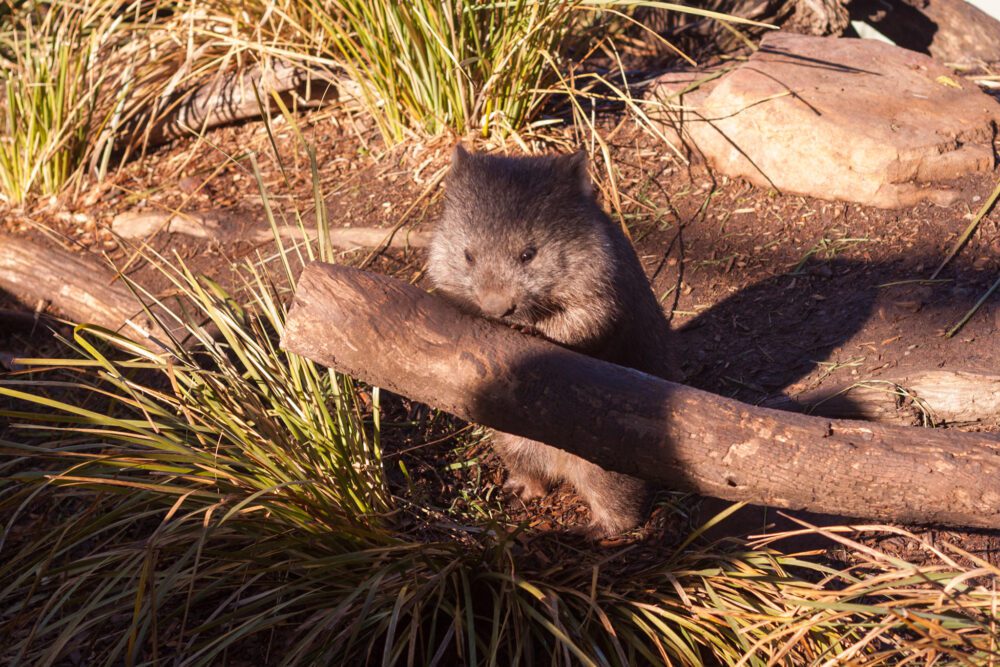
Bonorong is home to several resident Tasmanian devils, the unique carnivorous marsupial that is endemic to Tasmania, along with many other native Australian animals that have been rescued. You can say hello to wombats, hand feed Forester kangaroos, get up close with tawny frogmouths and many others.
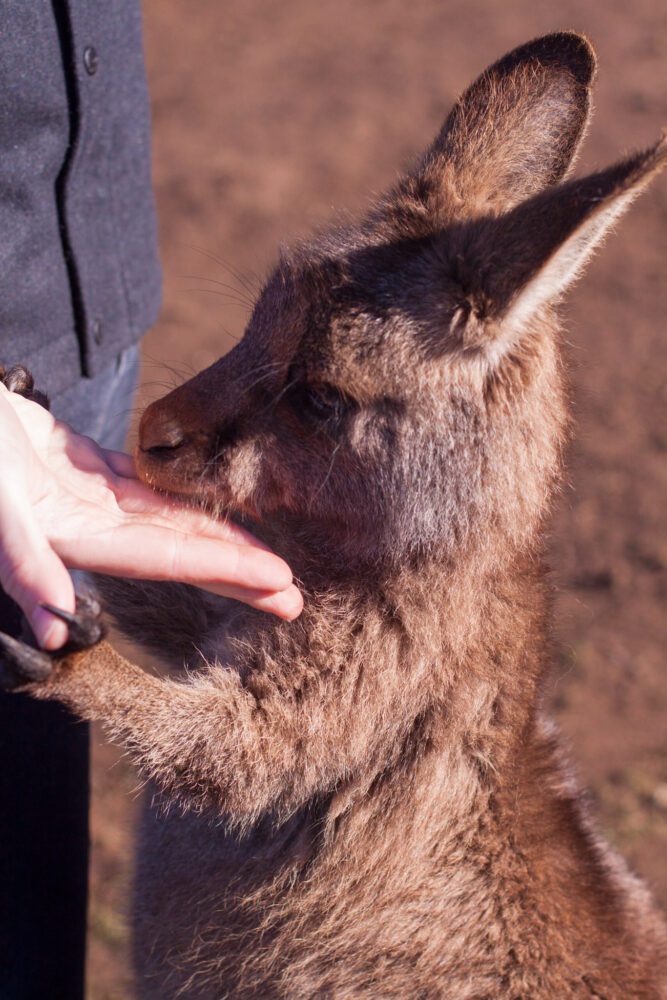
Note: You should never approach or try to feed a kangaroo in the wild. Kangaroos can be extremely dangerous.
The enclosures at Bonorong are reasonably close together, so you can see the animals in about an hour, including feeding the kangaroos with the included bag of kangaroo food. There are also 30-minute guided tours throughout the day of the Tassie Devils, Wombats and Echidna enclosures.

Pre-book your Bonorong tickets online:
- Book Direct
- KKday – Cheapest tickets at the time of writing
- Klook – Also cheaper than booking direct
- Obtenga su guía
From Bonorong, it’s time to head to the Tasman Peninsula, home to some stunning natural wonders, like Tasmans Arch, the Devils Kitchen, and multiple blowholes.
The Tasman Peninsula is also where we find the Port Arthur historic site.
There is so much to see on the Tasman Peninsula and the Forestier Peninsula that you will cross on the way. You can easily spend multiple days here to see everything, so we picked some of the key sights for this trip.
Port Arthur Historic Site
First up, Port Arthur. It is a 104km drive from Bonorong, so allow about 1.5 hours for the drive.
There are some food options along the way, and a cafe at Port Arthur.
Watch for Eaglehawk Neck; this isthmus connects the Forestier Peninsula to the Tasman Peninsula.
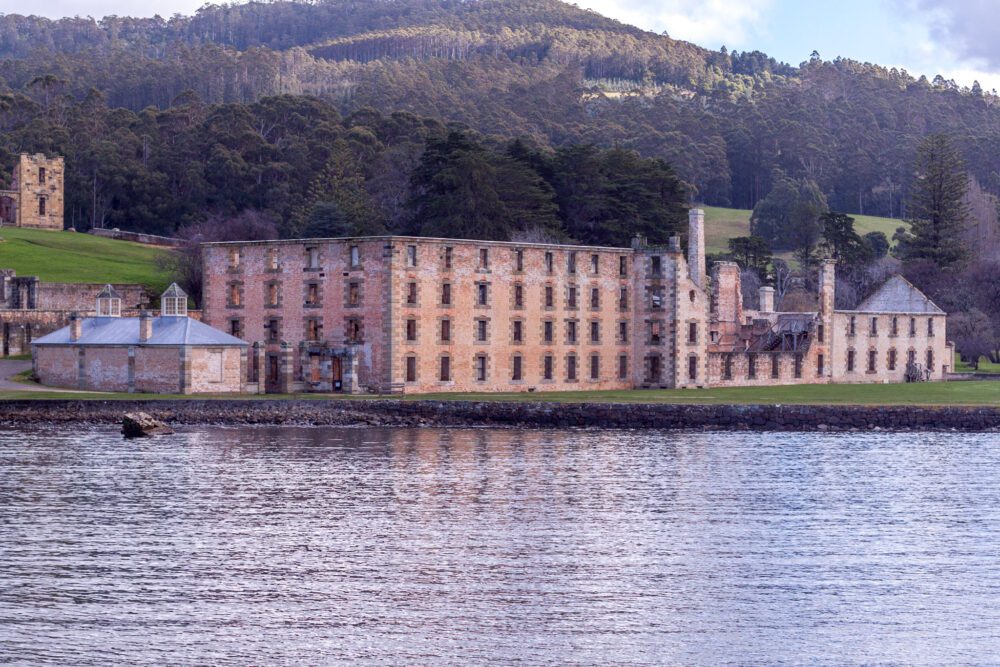
Entry to the Port Arthur Historic Site is paid, and while it’s not a cheap entry fee (AUD $47/adult & $22/child at the time of writing), there is a lot included, such as a 20-minute harbour cruise, audio commentary and talks at certain times. It is a two-day entry ticket if you do decide you need more time (and you have more time available to come back a second day). Visiting the key sights and exploring the main buildings in a few hours is possible, though.
Pre-Book Your Site Entry Tickets Online:
Additional tours are available at an additional cost. We opted to do the Isle of the Dead Cemetery Tour. This 40-minute tour includes a return cruise to the Isle of the Dead that provides much insight into life and death in the 44 years from 1833 to 1877 when this island became the final resting place of over 1000 people.
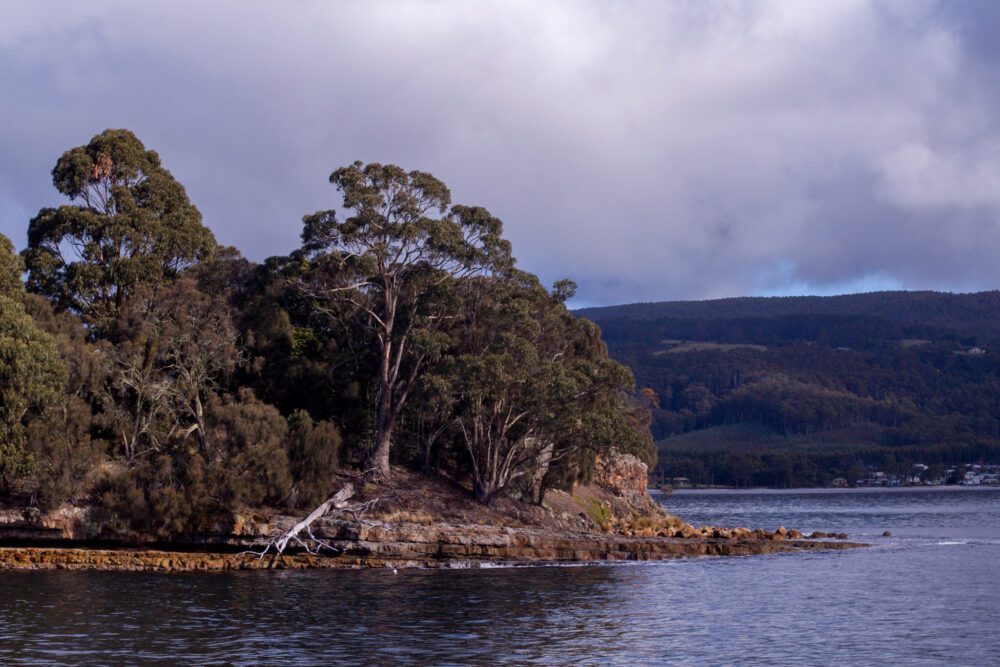
The Port Arthur buildings are in various states of ruin; however, the management authority has done a great job of preserving the buildings and history of the site. The included audio tour is comprehensive and comes together with information boards to give a detailed picture of what happened in each building and what life was like here.
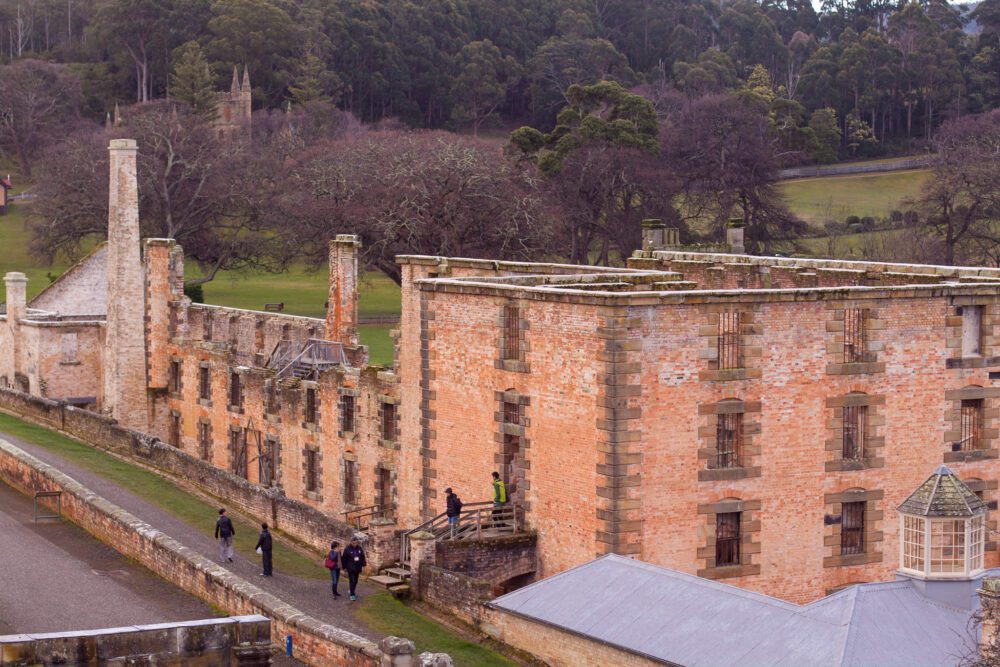
Port Arthur is one of Tasmania’s must-do activities. We spent three hours here to fit everything in on this day, including doing the Isle of the Dead tour. You could easily spend longer here if you have the time.
Fossil Bay, Tasmans Arch and Devils Kitchen
Returning up the Tasman Peninsula towards Eaglehawk Neck, turn right at Blowhole Road just before you cross the isthmus. Follow this road around Pirates Bay to the end of the road, and you will arrive at the Blowhole and Fossil Bay Lookout.
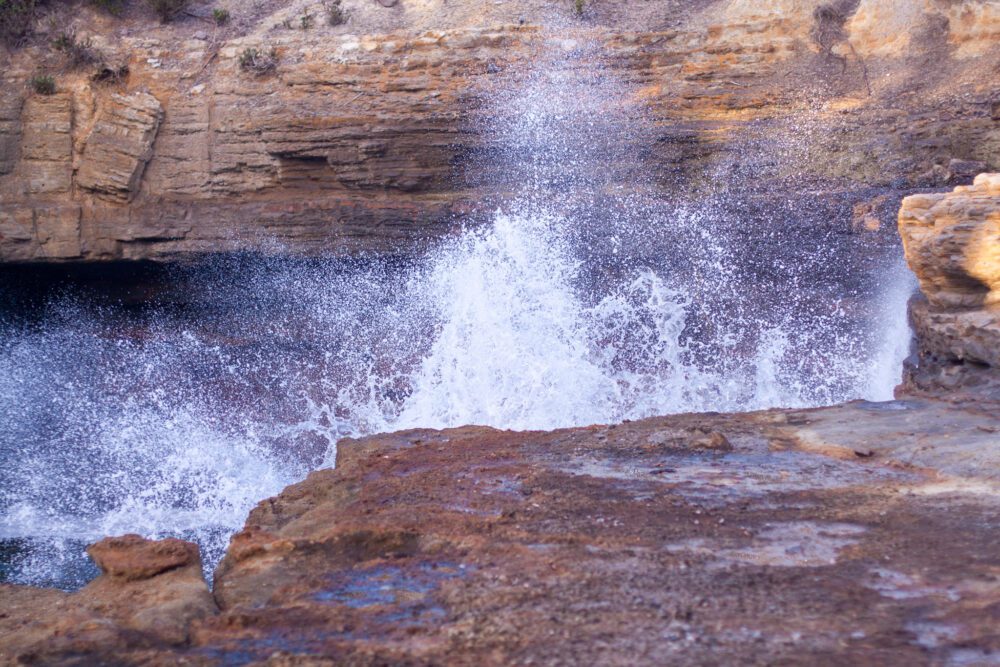
The Blowhole is only metres from the car park at the end of Pirates Bay, making it one of the more ‘convenient’ blowholes.
Located on a point, this blowhole appears near the ocean on the opposite side of the point from where the waves originate.
It’s the result of waves that have gradually worn away soft rock underneath a hill of harder rock. The result is a tunnel under the hill that bursts out near the ocean on the opposite side of the point.
It’s pretty cool.
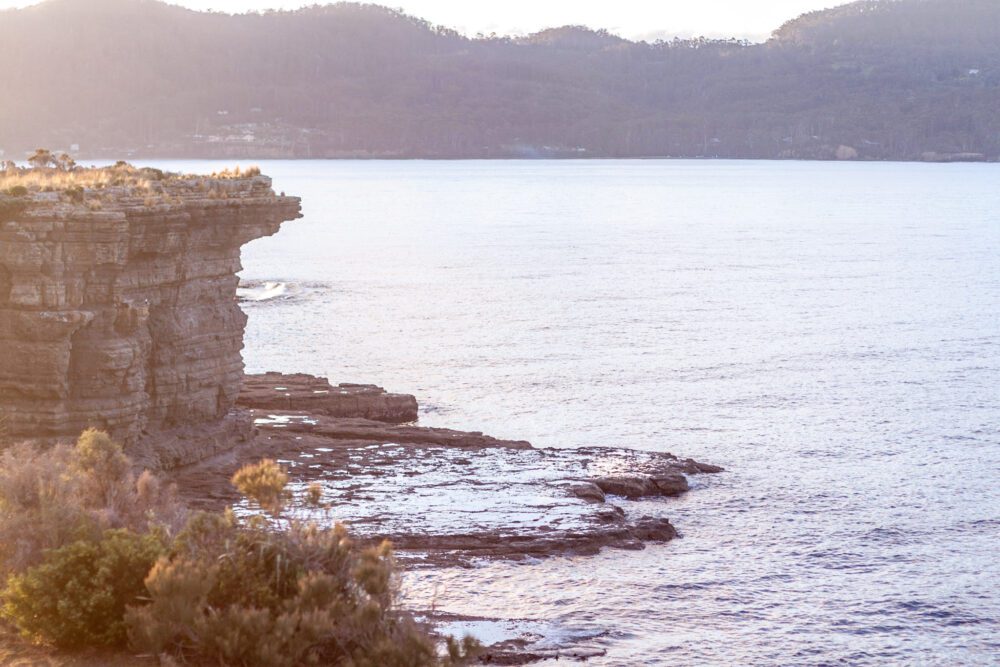
From the Blowhole, you can do a circuit walk that will take you around the point to Fossil Bay Lookout and will give you a great view North towards Fossil Island and onwards to the Forestier Peninsula as well as South towards Cheverton Rock.
If daylight starts to get low, you won’t have time to do the full circuit walk, but it is worth taking the direct path to the lookout and back.
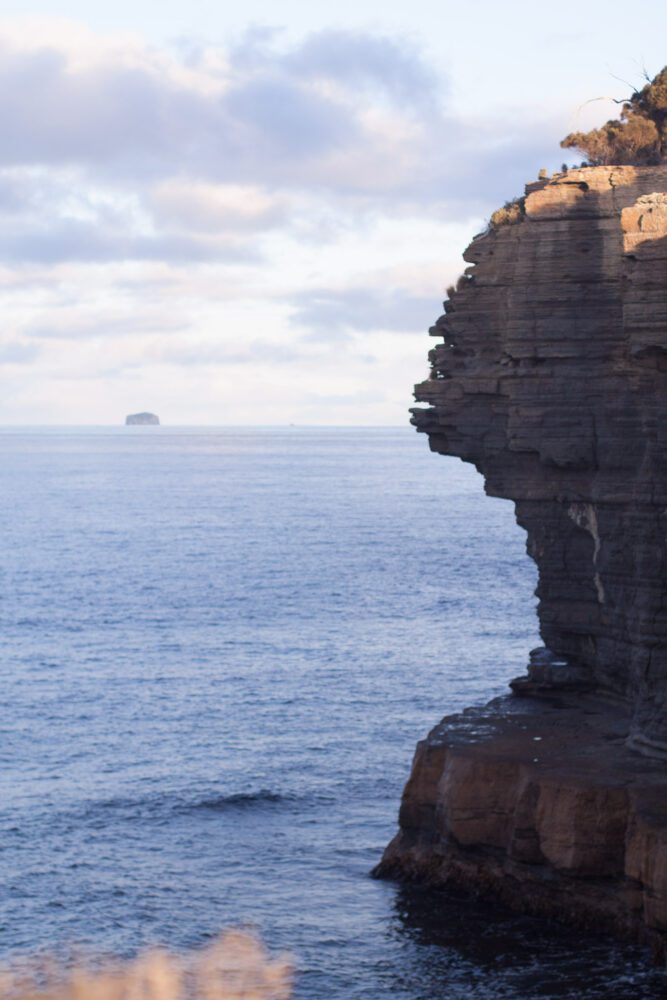
Both North and South from Fossil Bay Lookout give you a good idea of what the cliffs in this part of Tasmania are like, with both directions clearly worn away by waves and exposed outcrops left behind.
Next, head South to Tasmans Arch.
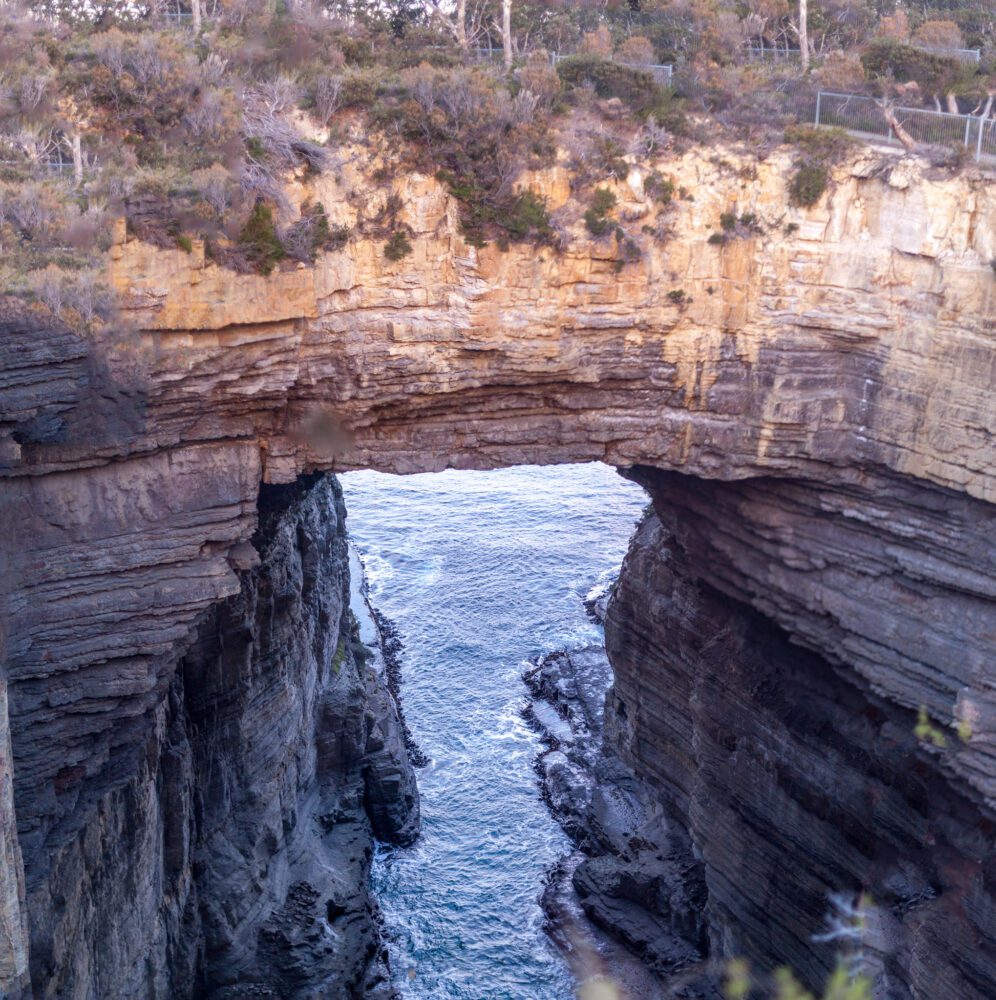
Like the Blowhole, Tasmans Arch is a rock tunnel where the softer stone has been hewn away by the waves and eventually, part of the roof collapsed to leave behind a natural bridge.
The car park is right by the opening of the Arch and there is a circuit walk around it called the Tasman Arch Track. This track also connects you to the Cliffs Lookout Point.
If you have time, it’s worth the walk to the lookout.
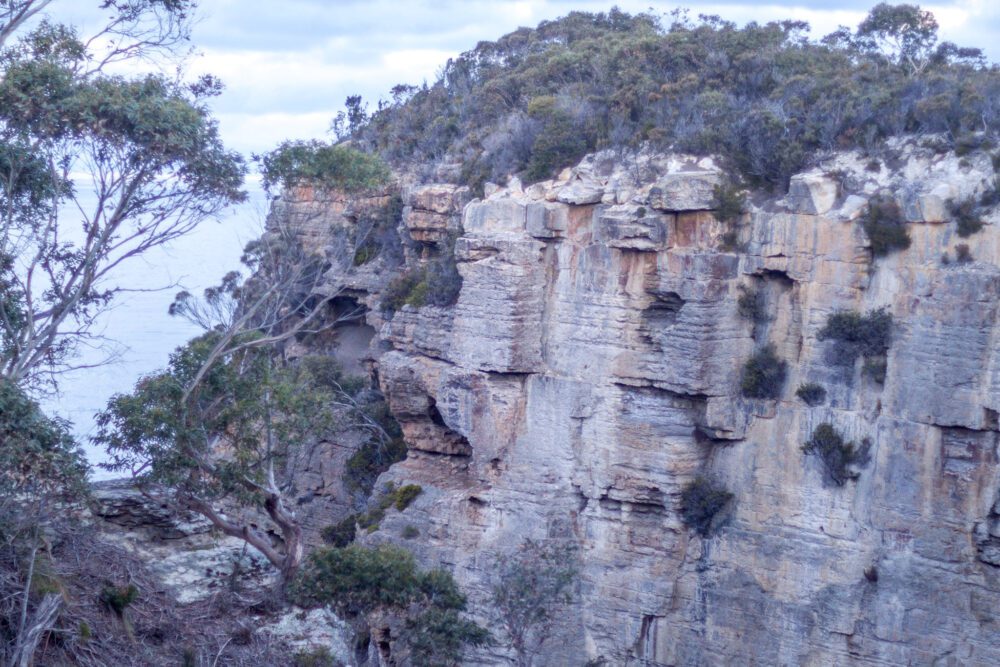
Just a little further south from Tasmans Arch, at the end of the Tasman Arch Track is Devils Kitchen. You can walk if you have time, or it’s a short drive to Devils Kitchen car park.
The 5-minute return walk to Devils Kitchen viewing point reveals a massive gulch worn deep into the cliffs and formed the same way as Tasmans Arch and Blowhole.

It’s a remarkable natural sight to see, and the waves continue to wear away new caves at the end of the gulch and in the surrounding cliffs.
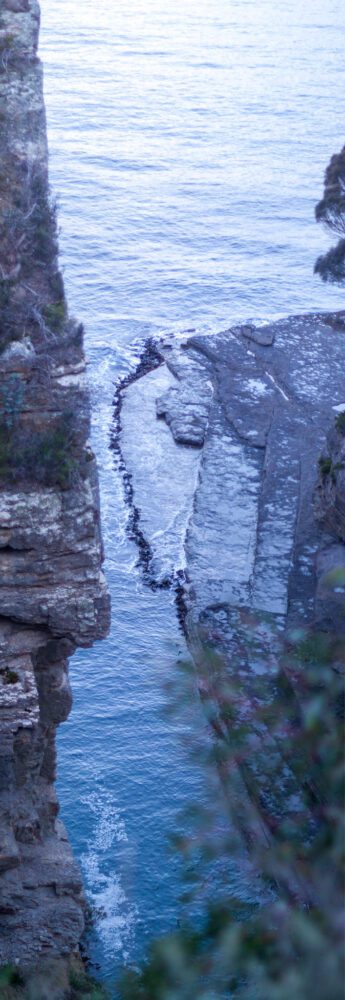
From here, it’s back to Hobart for the night. This is around 80km, and you should allow around 1 hour and 20 minutes for the drive.
It will most likely be after dark when you return to Hobart, so watch for kangaroos and other wildlife on the road.
Day 2 – Art and History
The second day in Hobart is all about art and history, most of which could easily be at MONA. However, we also headed out to Historic Richmond for more of Tasmania’s rich historical sites.
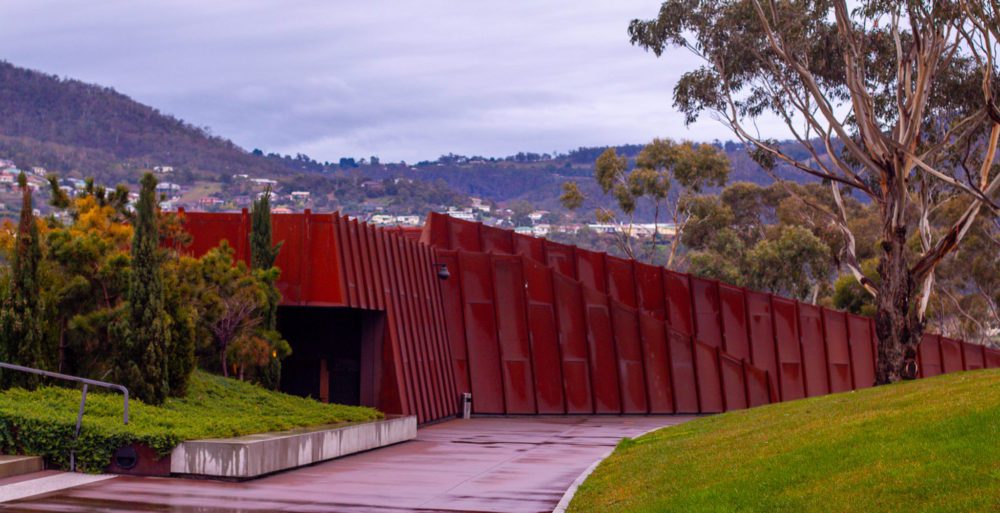
The Museum of Old and New Art – MONA
MONA is a unique, mostly underground, privately owned and funded museum located to the north of Hobart in the suburb of Berriedale.
MONA might also be one of the easiest places to get to, with privately operated ferries and buses available to get you from Hobart to the grounds and back.
Of course, you can also drive!
Entry to the grounds is free and is worth visiting anyway. Entry to the museum is free for Tasmanian residents, but for everyone else, it’s currently $35 for adults, and there are capacity limits, so make sure to book the time you want.
You can buy tickets directly, or you can get tickets as part of day tours like these ones.
Pre-book your MONA tickets online:
- Book Direct
- Viator – Tours with MONA admission included
- Klook – Tours with MONA admission included
- Obtenga su guía – Tours with MONA admission included
However, it is important to note that MONA is only open 10 am to 5 pm, Fridays through Mondays, so if you are planning to visit, keep those days in mind. It’s part of why we ended up doing this trip in the order we did.
Also pretty cool is that you can take photos of everything, just no flash photography or professional photography.
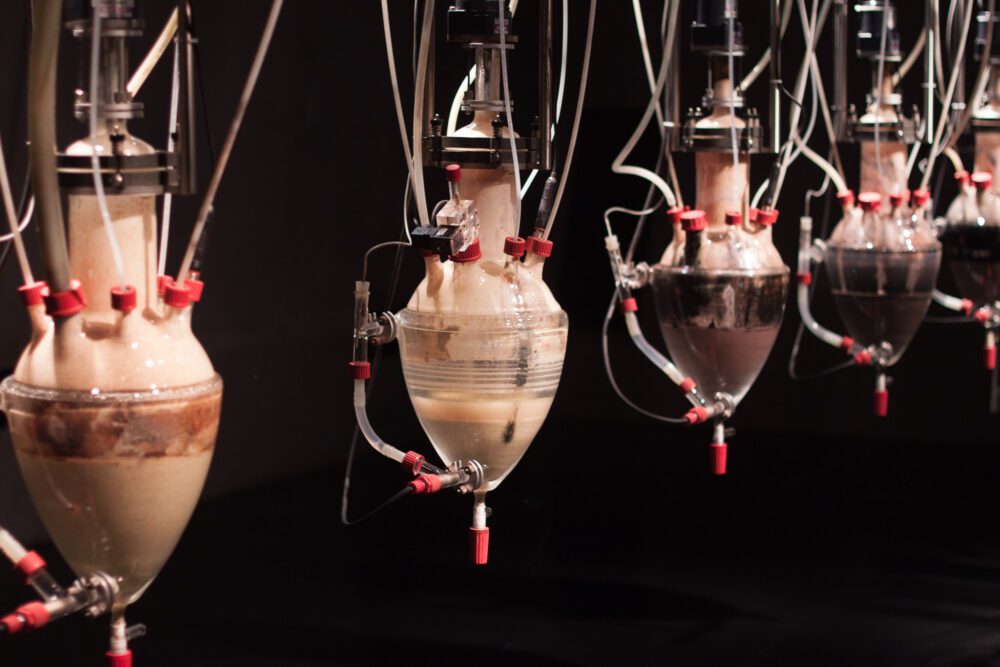
The variety of art and historical artifacts at MONA is extensive and well-curated, with a mix of related themes juxtaposed with old and new art in the dark, mostly underground location.
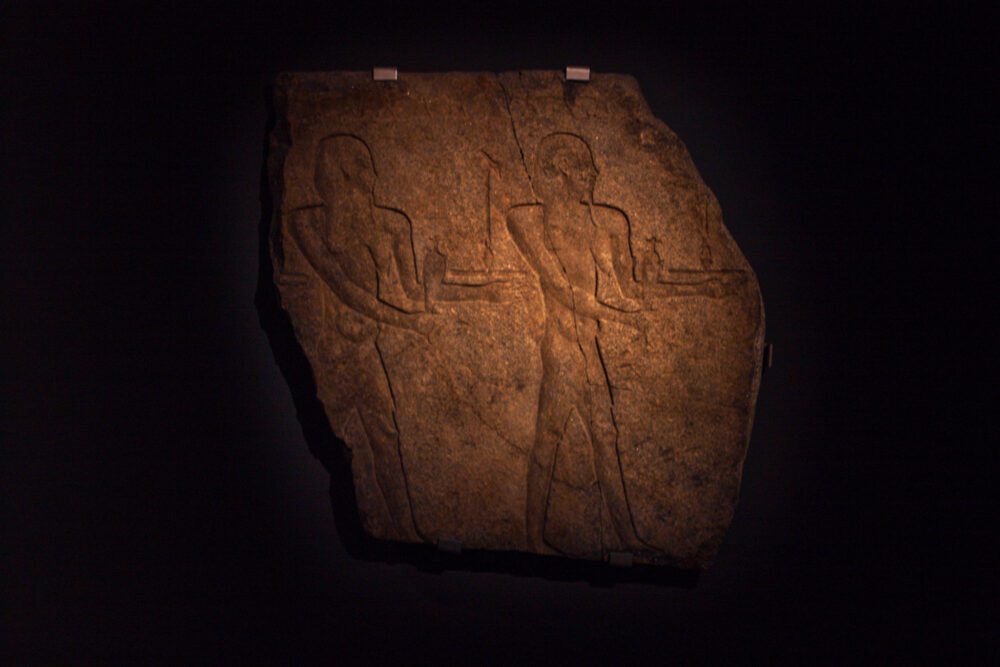
Depending on your level of interest, it’s possible to spend a lot of time here. We were here for about 4 hours.
Historic Richmond
It is about a 23 km drive from MONA to Richmond, which takes about 25 minutes.
Richmond is a small township built around Richmond Bridge, a sandstone arch bridge constructed by convicts over 17 months from 1823 and officially opened in April 1825.
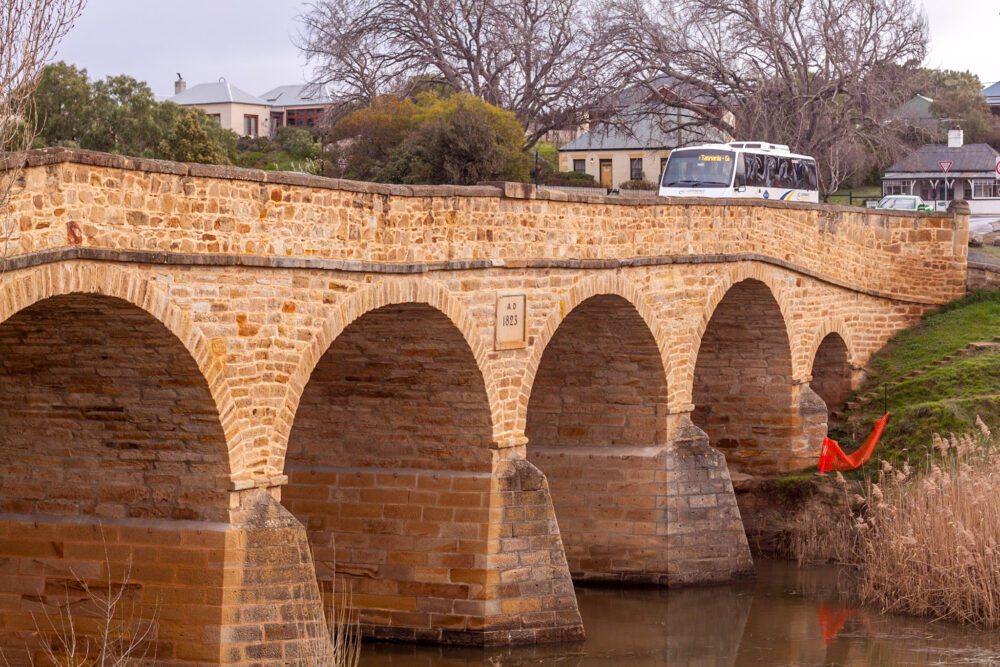
Today, Richmond Bridge is both the oldest stone-span bridge in Australia and the oldest bridge still in use in Australia – it even handles two-way vehicle traffic (albeit at a reduced speed limit). This is a bridge that was built to last!
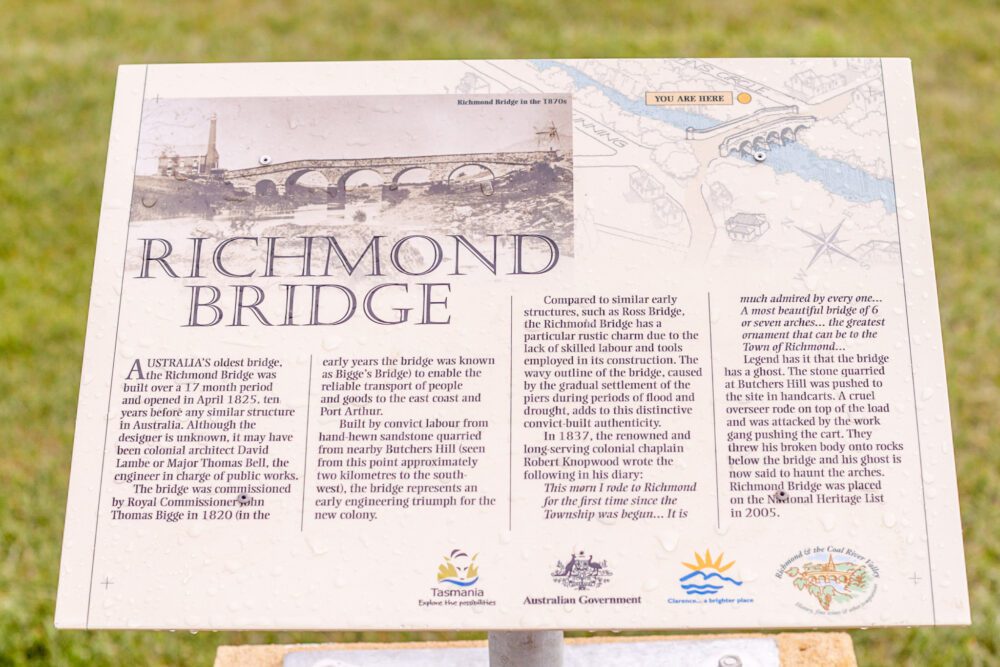
One of the other attractions is the historic Richmond Gaol. Building commenced in 1825, making this the oldest intact gaol in Australia.
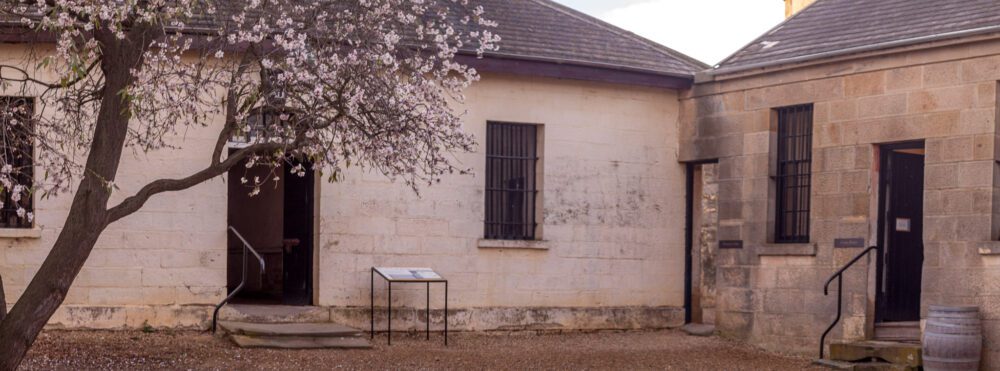
Richmond is also home to two of Australia’s oldest churches.
St Luke’s Anglican Church was built in 1834-36, making it the oldest Anglican church in Australia.
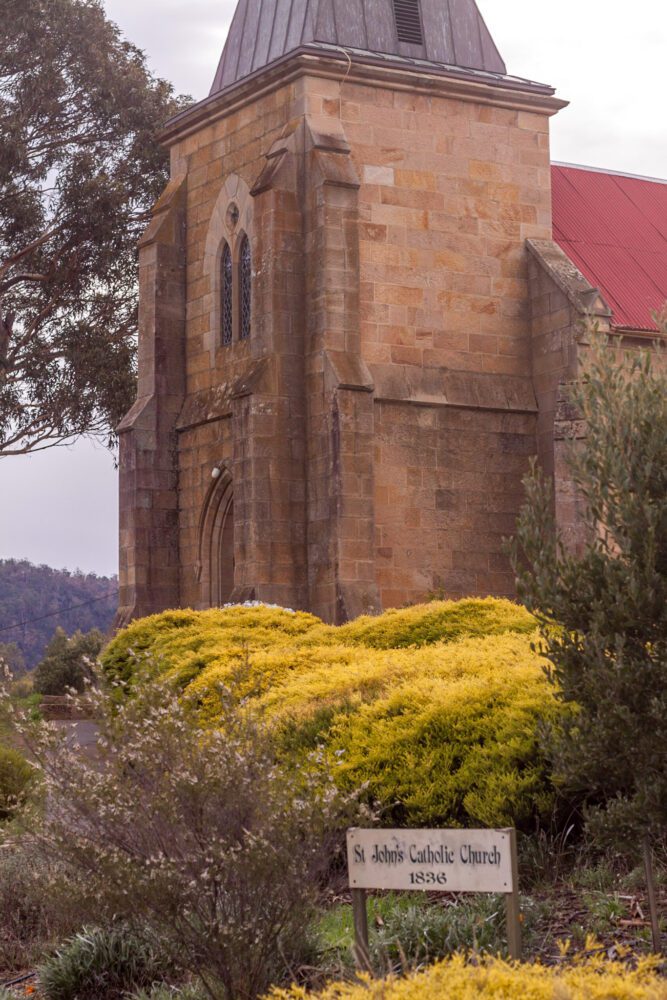
Then on the other side of town (right near Richmond Bridge) is St John’s Catholic Church, the oldest Catholic Church in Australia, built soon after St Luke’s in 1836.
Once you are ready, head on back to Hobart for the night.
Day 3 – Hobart City
Hobart City is full of history. From our accommodation at Zero Davey, it’s an easy walk around Victoria Dock and Constitution Dock, where you can spot many historic buildings, the old steam crane, and various ships, some of which look straight out of the 1800s.
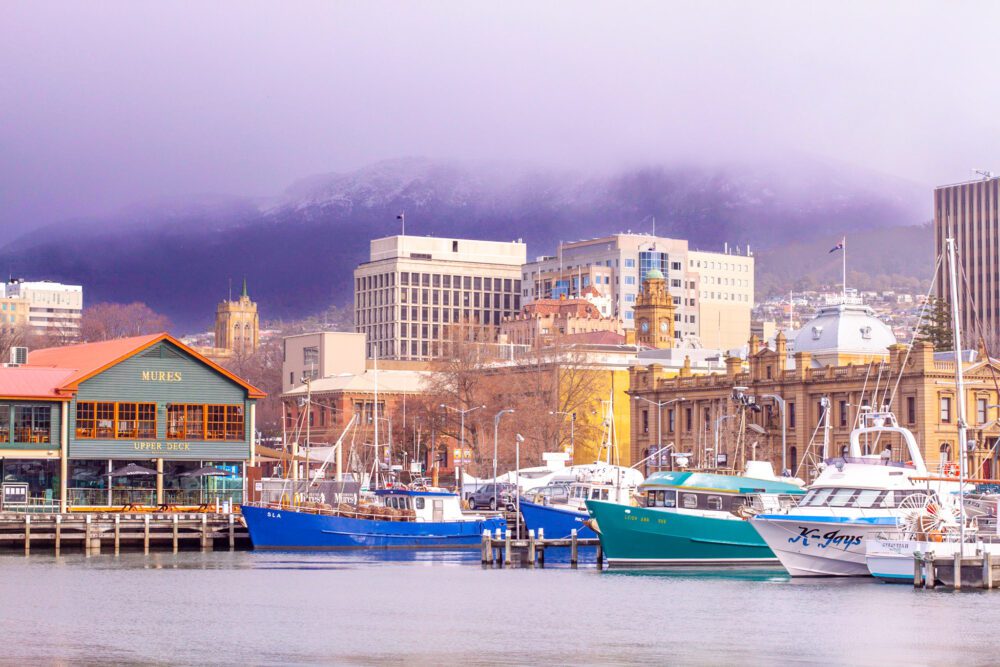
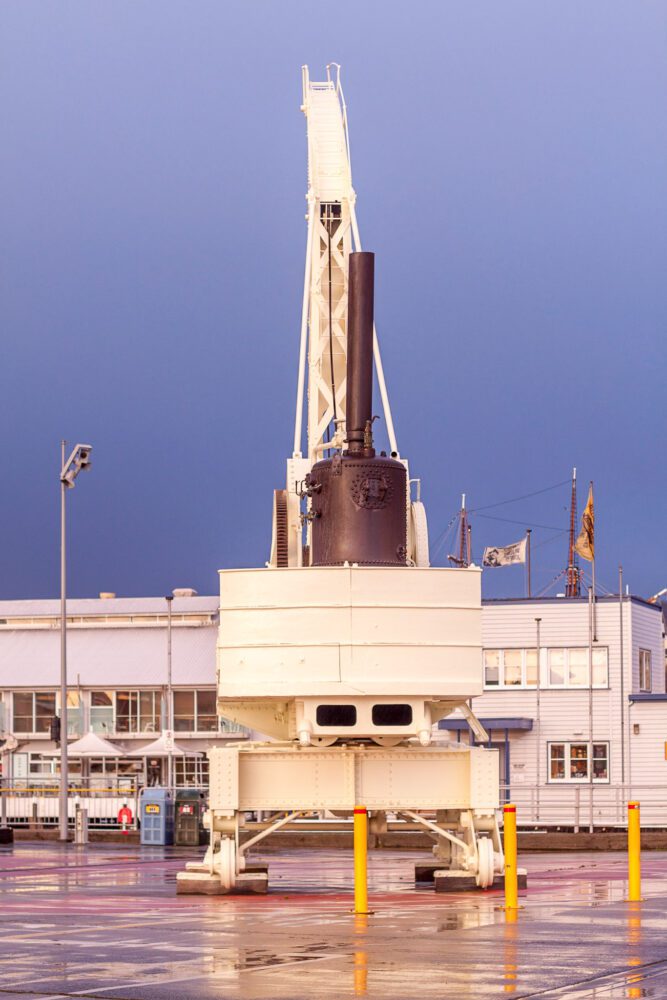
Salamanca Market
Salamanca Place connects key sites like St David’s Park, Parliament House Gardens and Constitution Dock to Princes Park and Battery Point.
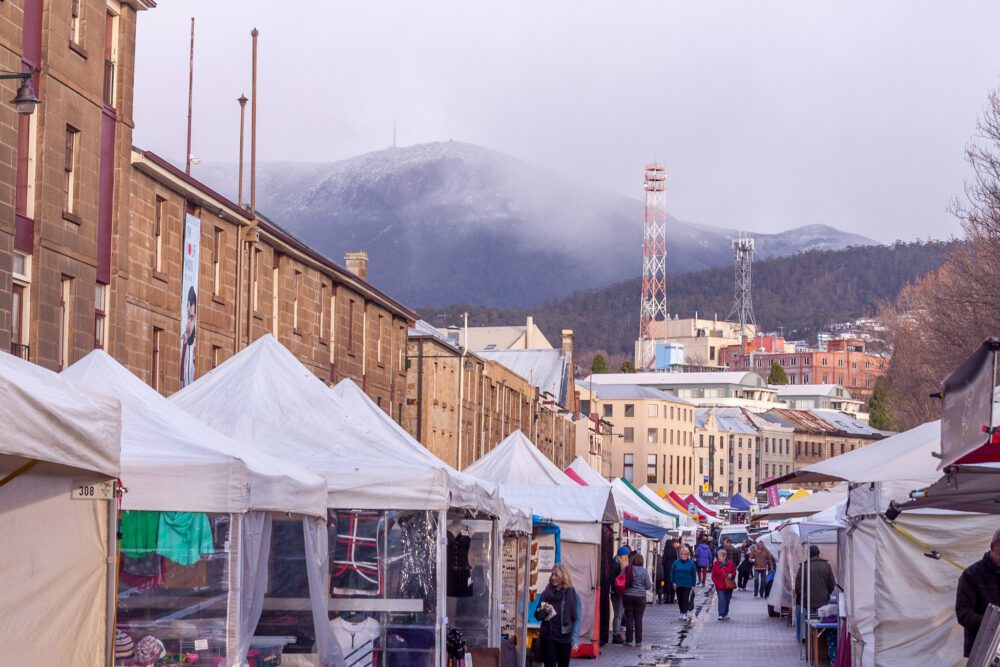
This street is full of history, lined with heritage buildings that lend their charm to the area, and on Saturday mornings, Salamanca Place becomes home to the famous Salamanca Market. This market brings together many Tasmanian businesses and claims to be one of Tasmania’s most visited tourist attractions!
Princes Park
At the end of Salamanca Place you will find yourself in Princes Park at Battery Point, home to more Hobart history.
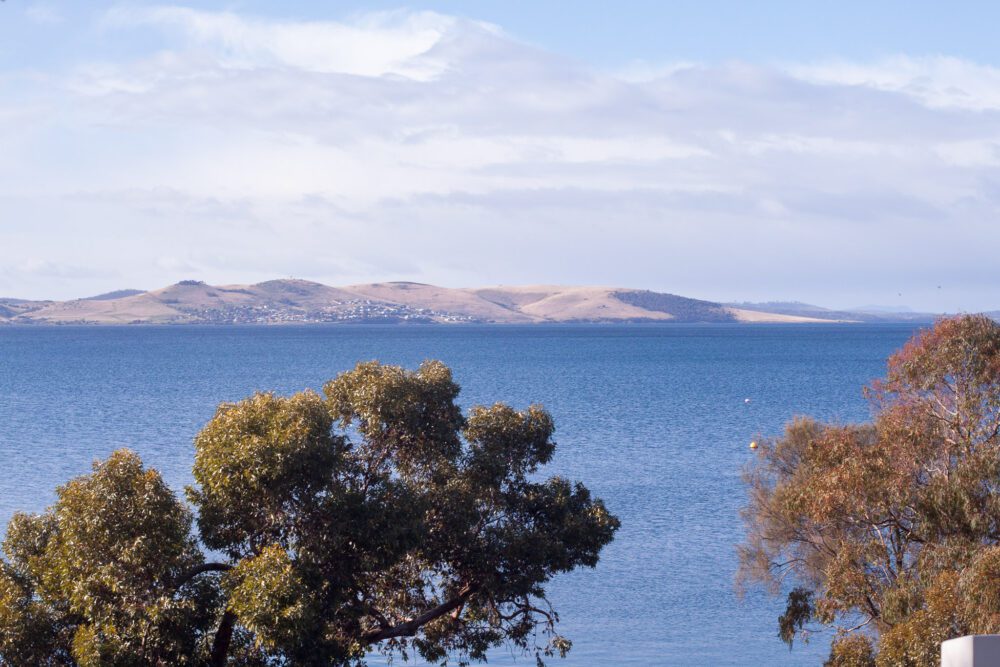
Within Princes Park are the Hobart Semaphore Station and Signalman’s Cottage. If you look closely, you can also find the Princes Park Magazine, part of the first military battery in Tasmania that was built in 1840.
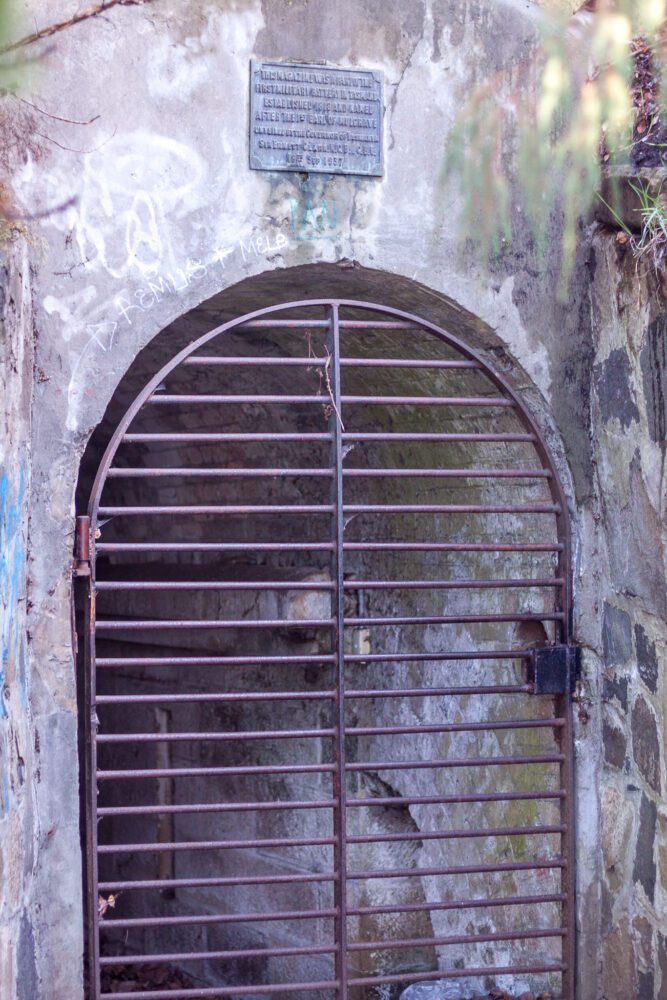
The magazine is closed to the public except for organised events like those run by Open House Hobart, but you can still take a peak through the gated entrance.
Hobart Convict Penitentiary
Once you are ready, hop in the car or walk the few blocks up to the Hobart Convict Penitentiary on the corner of Campbell Street and Brisbane Street, which served as a chapel, jail and courthouse for male convicts.
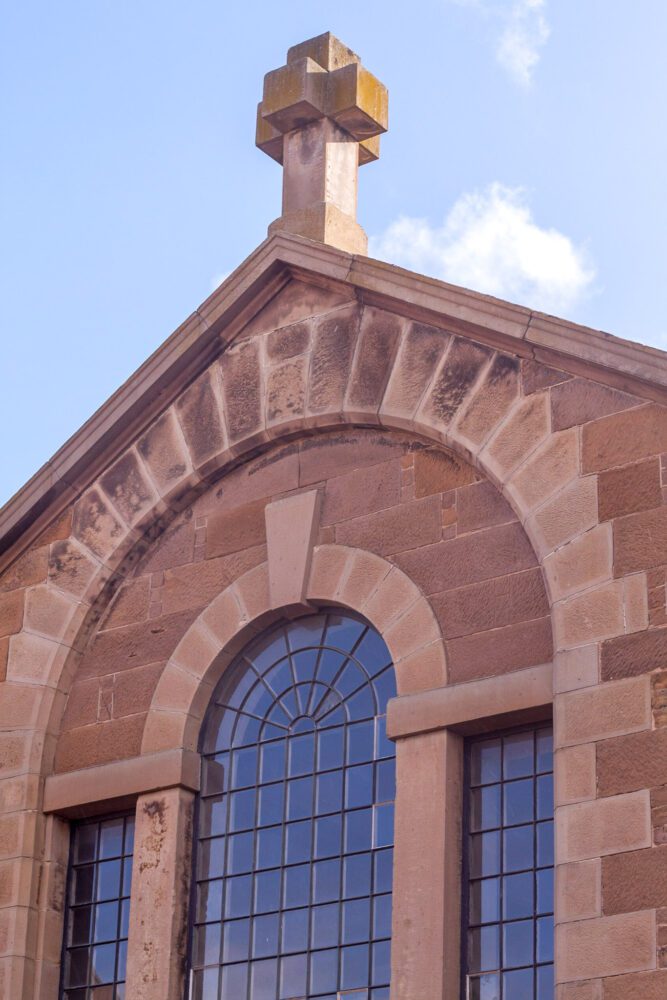
There are limited free parking spaces available on the grounds; however, metered street parking is available.
If you don’t feel like walking or dealing with parking, you can take the bus or get a Hobart Hop-On Hop-Off pass for the day as it goes right by the Convict Penitentiary (as well as Princes Park and many other Hobart city points of interest).
I do think it is a bit expensive at $40 per person, though, especially on top of site entry fees. However, if you were to spend a couple of days using it, at $50 per person for 48 hours it is a much better price!
Pre-Book Your Hobart Hop-On Hop-Off Bus Tour Tickets Online:
You can enter the small gift shop area for free. However, entry to the rest of the Convict Penitentiary is by guided tour only.
Tickets are quite expensive, in my opinion, at $35 per person for adults and $20 per person for children 7 years and over. However, the 90-minute tour with a 15-person maximum is fascinating, and the guides really know their stuff.
Pre-Book Your Site Entry Tickets Online:
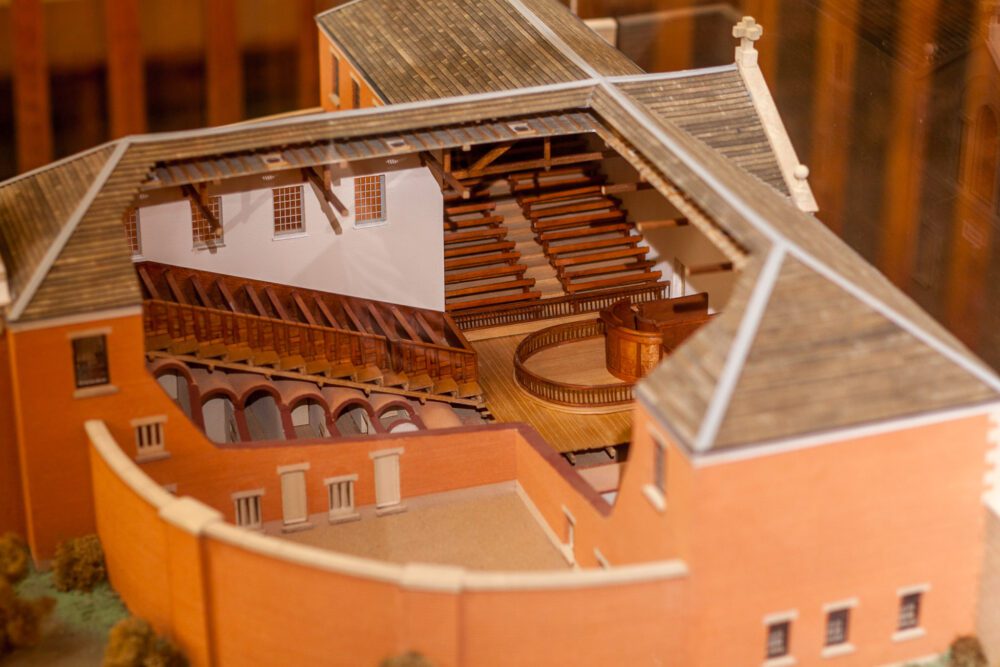
The Convict Penitentiary, originally the Hobart Prison Barracks, processed all the male convicts arriving in Van Diemen’s Land after 1821.
The building served many different purposes over the 100+ years it was operational, including as a chapel, gaol, courthouse and gallows.
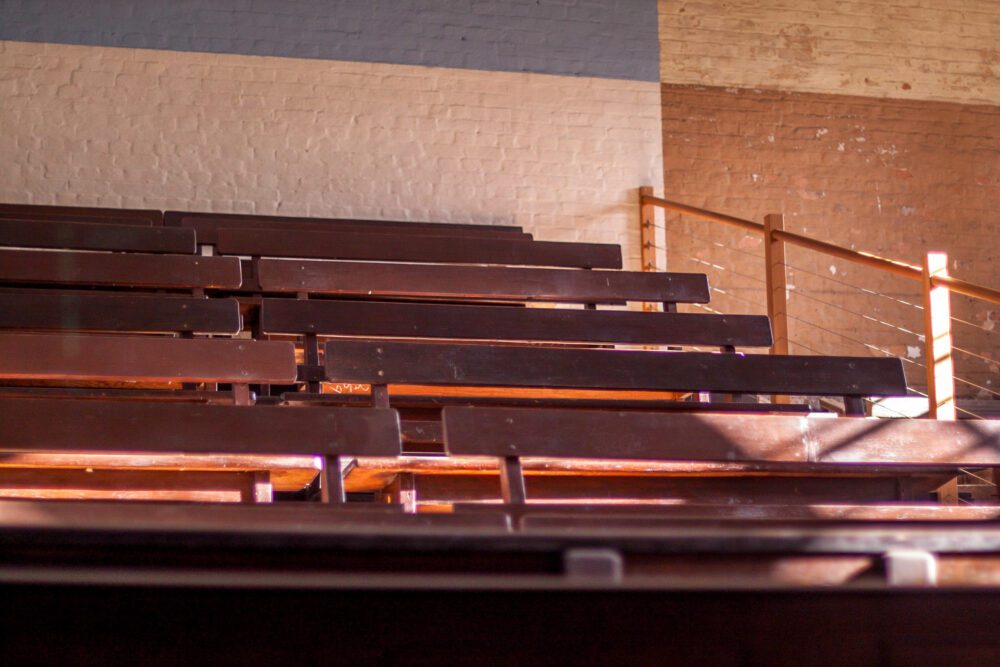
The penitentiary underwent many changes during the many years it operated, and the guided tour takes you deep into that history, showing you how it operated and where all the hidden tunnels are.
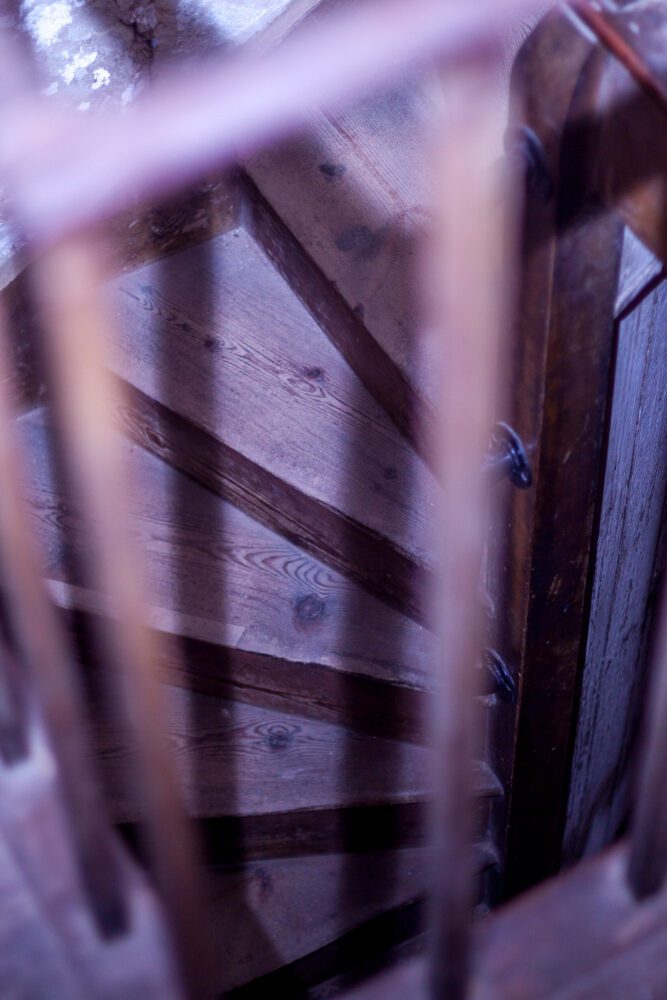
Like Port Arthur, the Hobart Convict Penitentiary is a confronting look at Australia’s convict heritage and how harsh life was for convicts sent here.
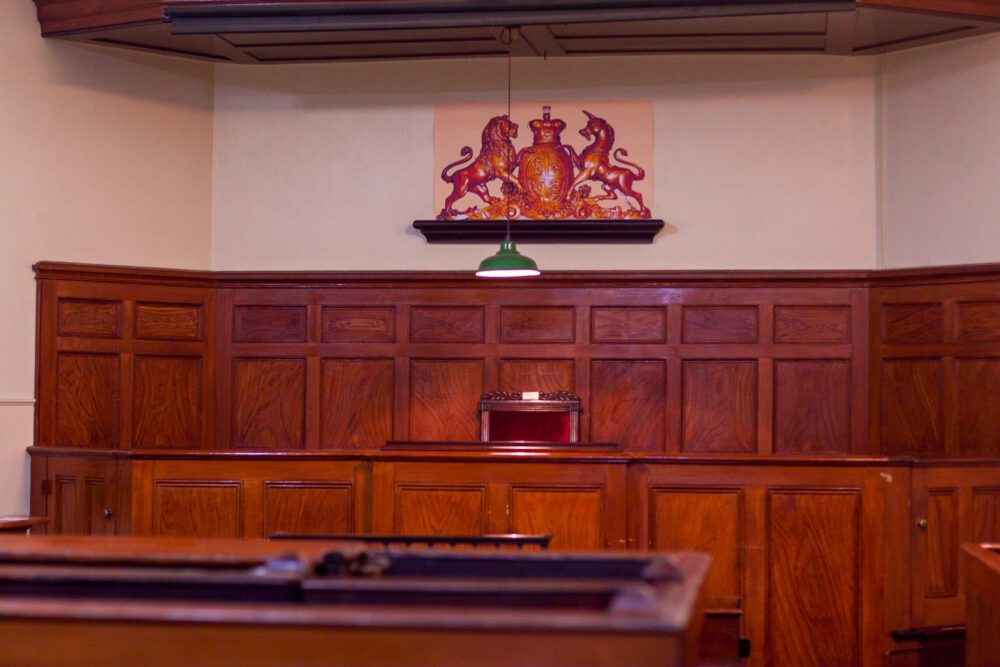
The tour is excellent, but many spaces are narrow and require good mobility to access. Lighting is also low in some of the underground sections.
Taroona Shot Tower
Head south to Taroona to visit The Shot Tower Historic Site.
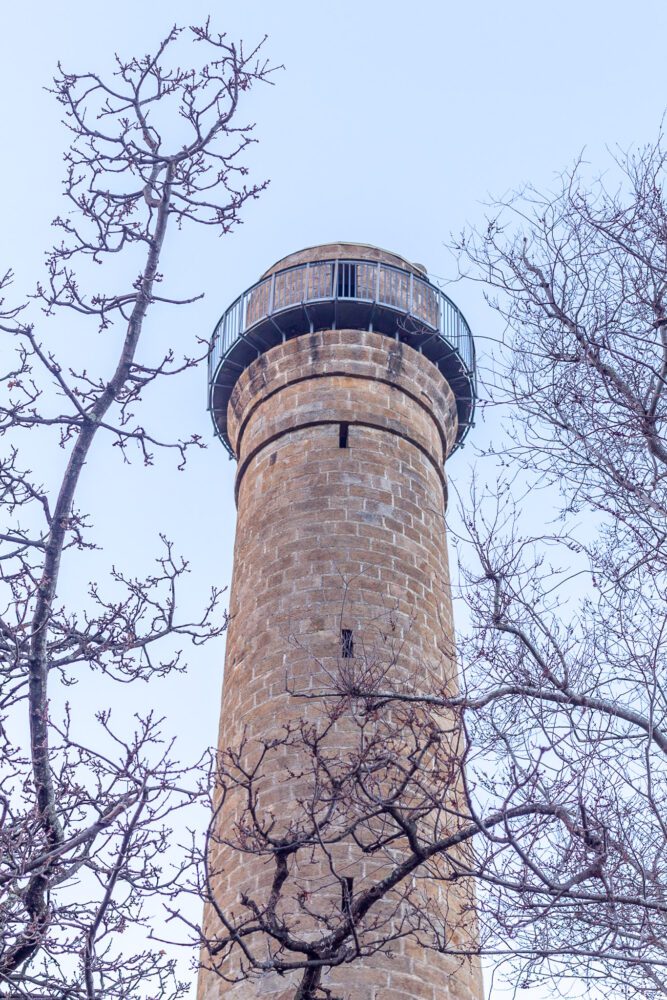
It’s about a 20-minute drive to this 58.7-metre-tall tower built in 1870 for producing lead shot balls.
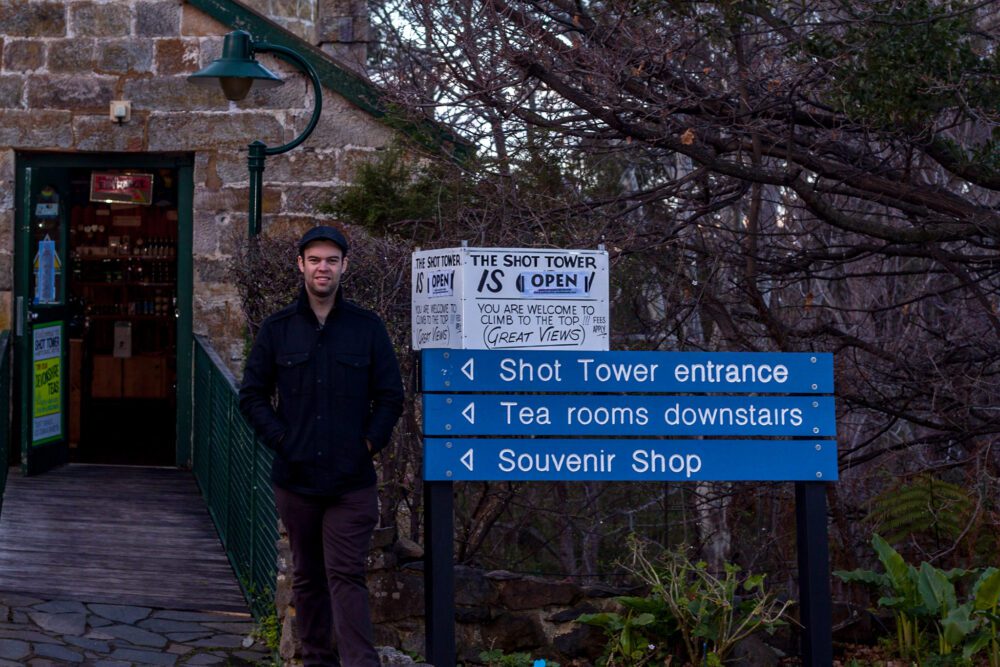
You can get here via the A6 Southern Outlet Road, which is the quickest, but it’s mostly just highway, so not particularly interesting.
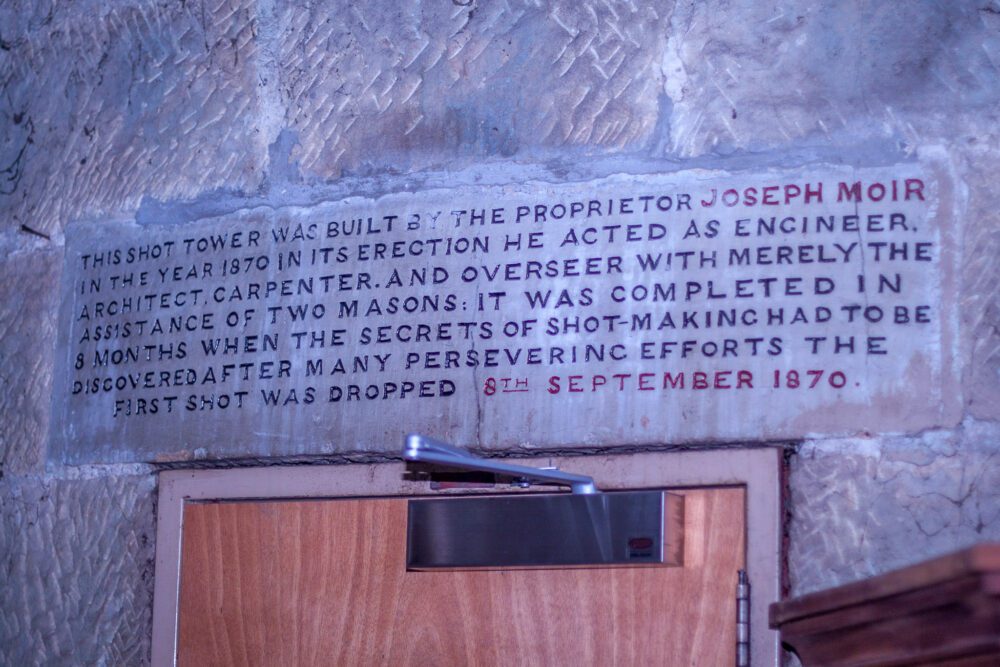
I’d suggest following the coast to Taroona on the B68 Sandy Bay Road for a more interesting drive. You’ll probably want to grab some lunch on the way if you haven’t already!
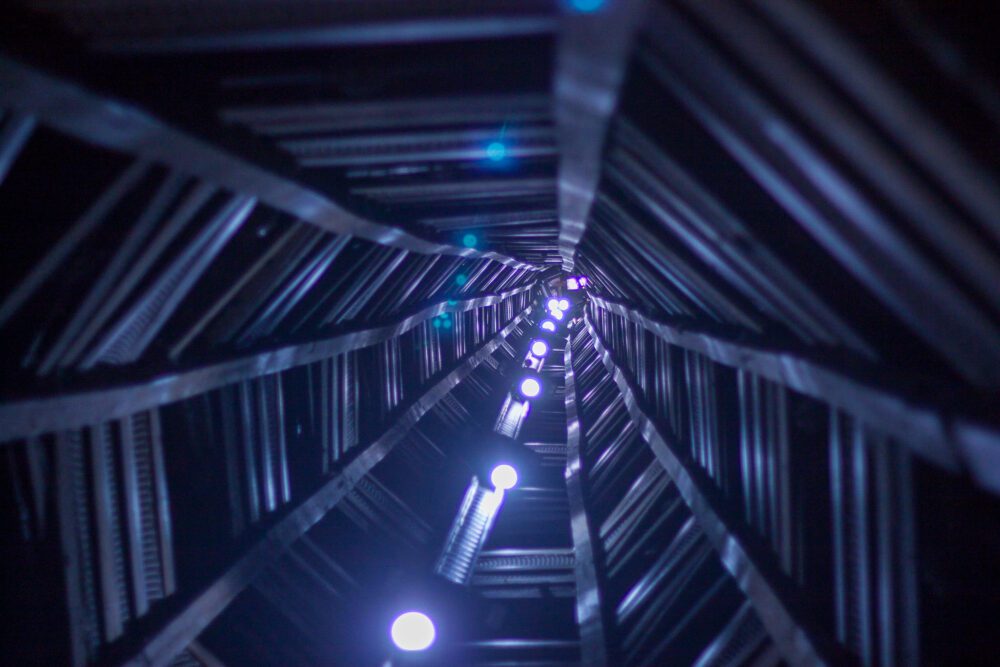
The Shot Tower is beside the road, so you can’t miss it!

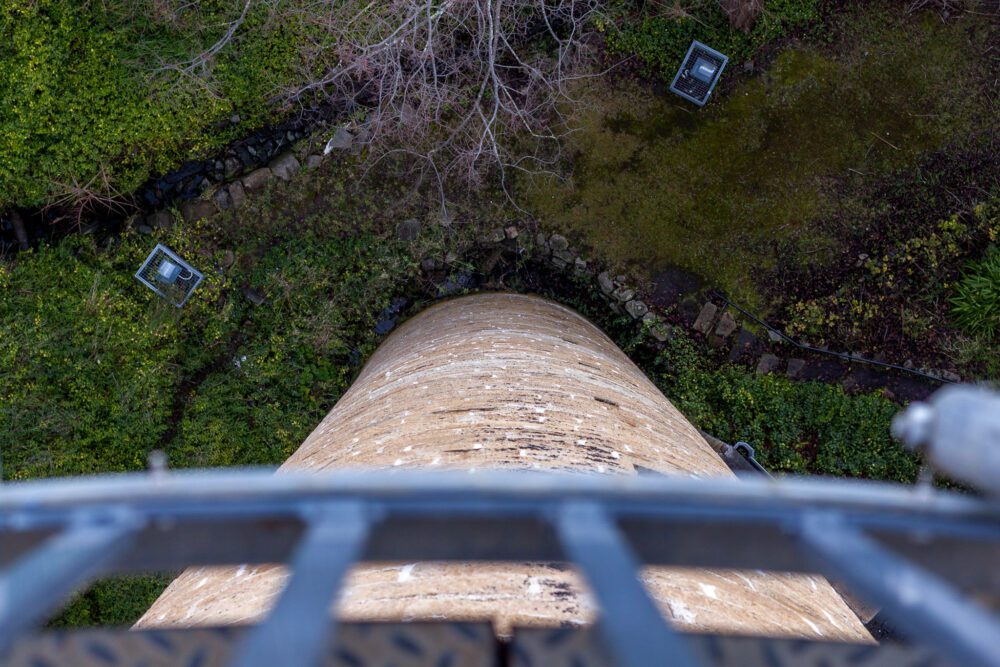
Mt Wellington Summit Drive
Depending on how much time you have left in the day, you may be able to make it up to the summit of Mt Wellington (or you might prefer to do it instead).
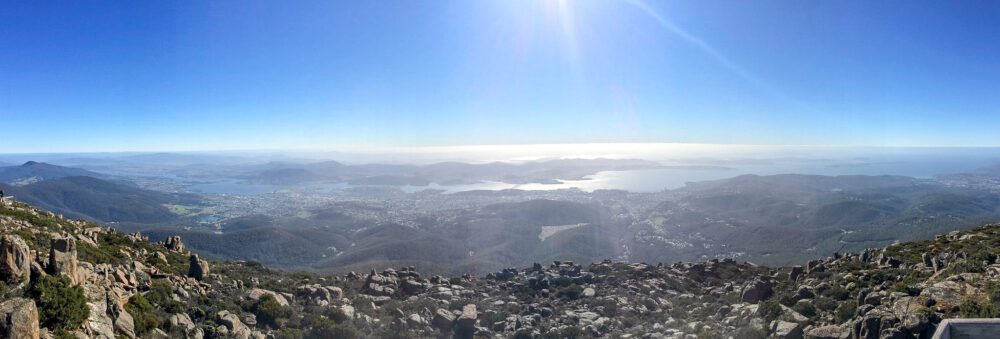
We didn’t have time to squeeze it in on this trip but we have done it multiple times on other trips.
There are several lookouts on the way up and at the summit there are both sheltered and open viewing points that give panoramic views across all of Hobart and beyond.
If you have the time, it’s worth doing!
Day 4 – Freycinet Day Trip
Today is the day we head out of Hobart (again) to the iconic Freycinet National Park and Wineglass Bay – considered one of the top 10 beaches in the world, according to Tasmania. Not everyone agrees, but it is a pretty special beach regardless, and probably up there as one of the top 10 beaches in Australia!
Chances are, if you’ve researched must-see places in Tasmania, you’ve come across Freycinet. It is popular for photography workshops and tours to Wineglass Bay, with many well-known professional photographers frequenting the area. Even without photography workshop visitors, this bay would probably still be one of the most photographed locations in Tasmania.
Please note, a valid National Parks Pass is required for entry to Freycinet National Park. You can pre-purchase yours online, or at the Freycinet National Park visitor information centre. Find out more on the Tasmania Parks and Wildlife Service website.
Hobart to Wineglass Bay Drive
Get on the road early to make the most of this spectacular part of Tasmania, as it’s a 200km drive that will take you about 2 hours and 40 minutes to get to the Wineglass Bay track car park without stops.
The Tasman Highway will take you past protected bays and beaches that look east, so if you are on the way early enough, you can watch some pretty spectacular sunrises over these bays.
We got underway at 6:15 am to make the most of the day!
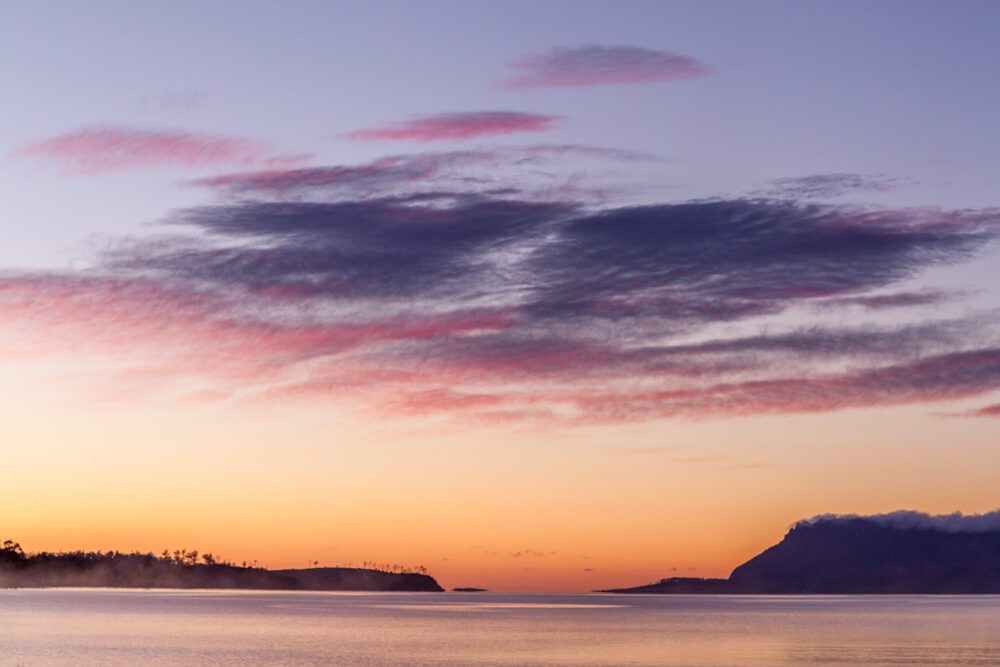
As you meander your way along the east coast of Tasmania, you will pass through some small towns, including Swansea, which looks across Great Oyster Bay towards Freycinet Peninsula.
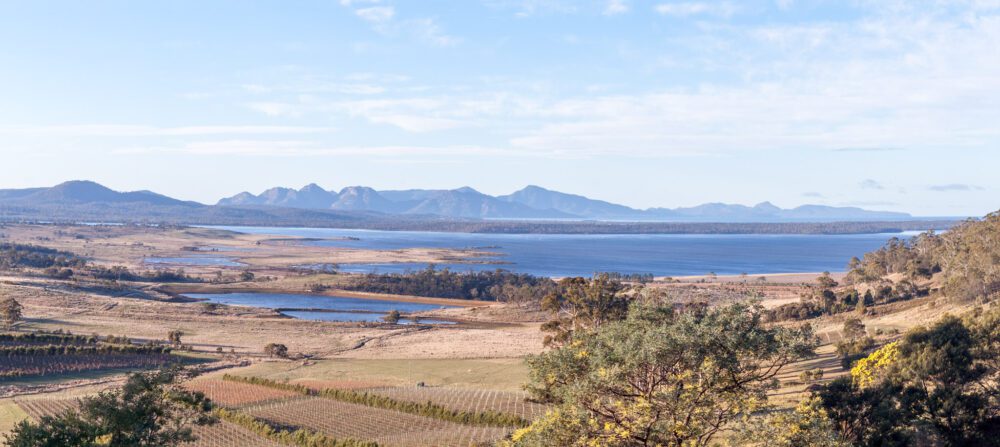
As Schouten Island and the peninsula become more apparent, it’s easy to feel like you are almost there, but it is still an hour’s drive from Swansea to the Wineglass Bay lookout car park, so you might want to take a pit stop in Swansea.
Coles Bay
The last town before arriving at the lookout car park is Coles Bay. This little township is located within Freycinet National Park and was a whaling station from 1824 to the 1850s. Now, it’s a quiet little town of just over 500 people.
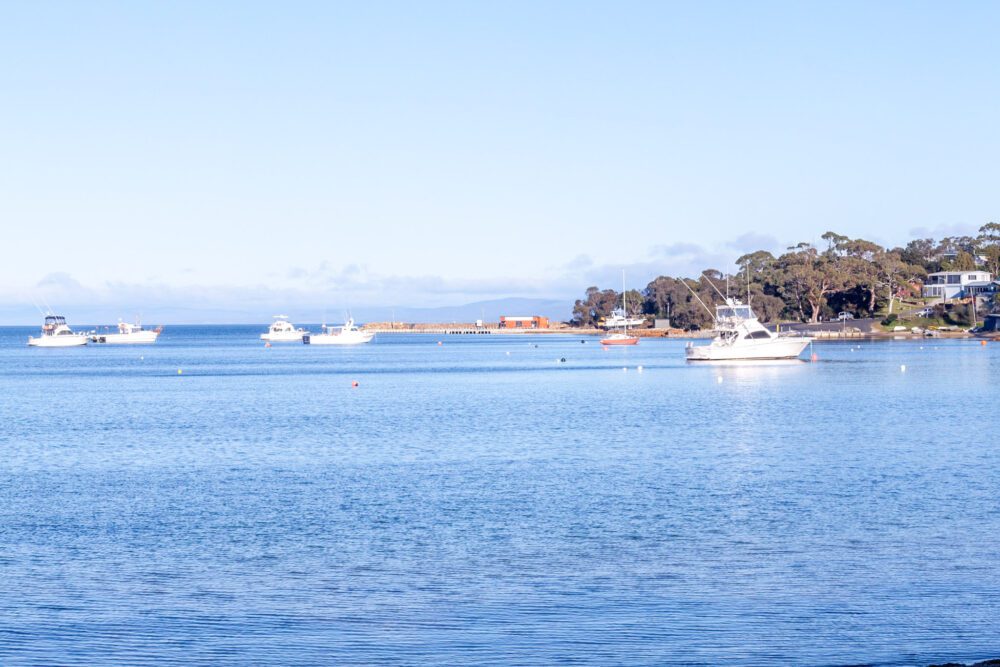
Bahía de la copa de vino
Head to the Wineglass Bay Track car park to start the walk. The track is pretty good, but it is an uphill walk that can be steep in places. We got to the car park at about 9:15 am and got started on the walk.
Walking Distance: 3km round trip
Time: 1-1.5 hours return
We took about 40 minutes each way to do the Wineglass Bay Lookout walk comfortably.
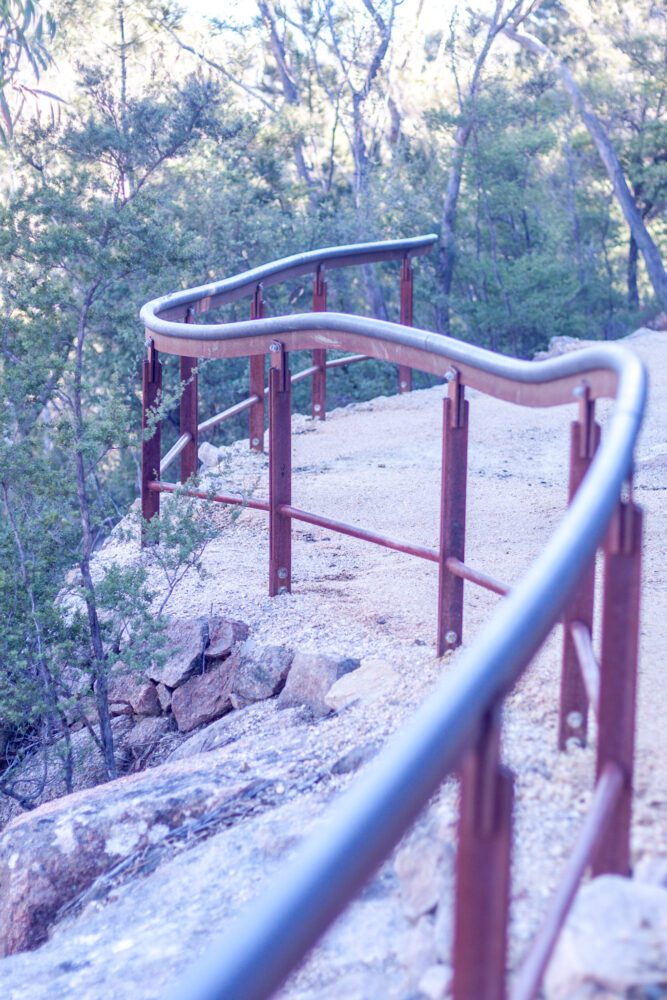
On the way up to the Wineglass Bay Lookout, the Coles Bay Lookout gives you a pretty good view back to Coles Bay.
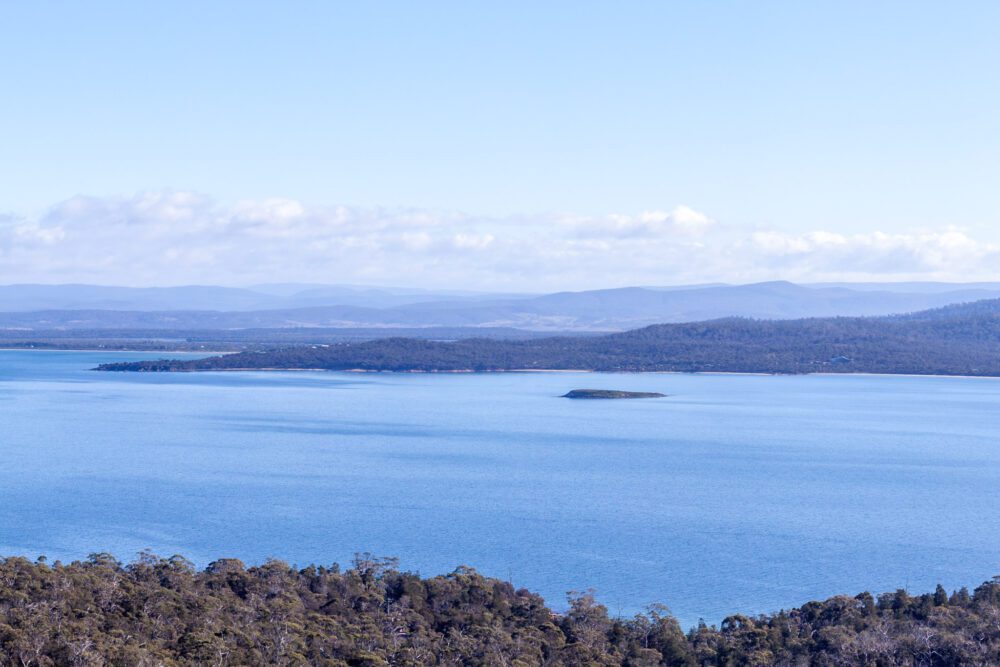
Continuing up the track will bring you to the Wineglass Bay lookout. This is what you are here for.
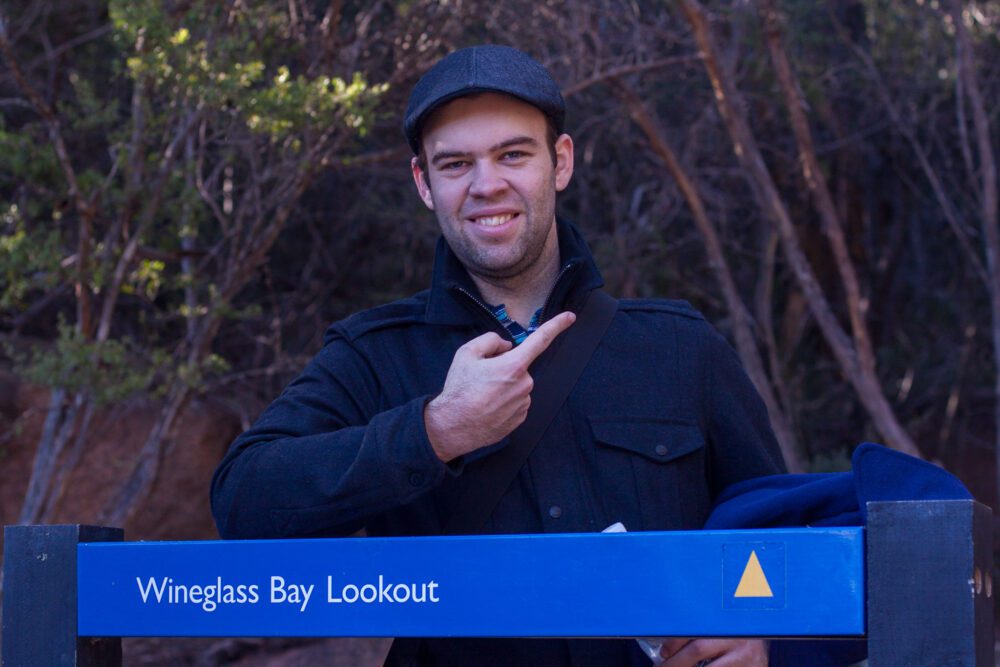
The path up is a bit rocky in places, but there is a great viewing platform and rest area at the lookout. You can take in the brilliant blue Wineglass Bay vista from that vantage point.
I made the mistake of only bringing my Canon f1.4 50mm lens on this day. I love that lens, but it just doesn’t do this magnificent landscape justice and I had to stitch together the panorama below!
Definitely, definitely take a good wide-angle lens! If you are using Canon, I am a big of my f2.8L 16-35mm wide-angle lens. That one would have been much better for this view!
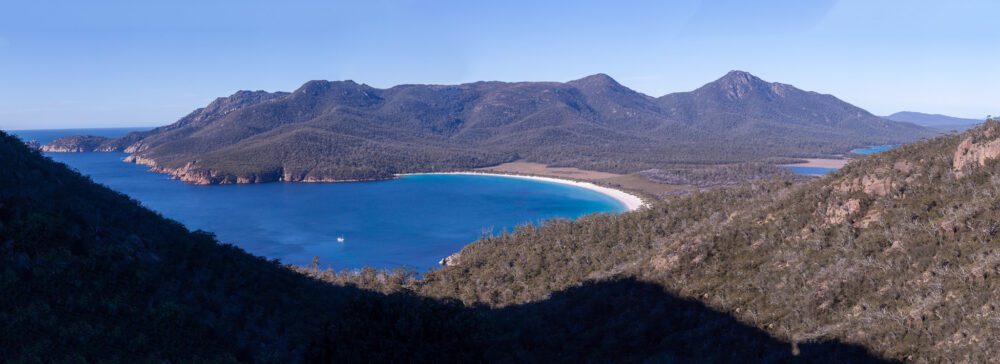
The blue water is more vibrant on a sunny day, but you won’t be disappointed (as long as it isn’t pouring rain)!
If you are feeling particularly enthusiastic and are suitably prepared, the Hazards Beach Track, which starts below the lookout, will take you down to the white sands of Wineglass Bay beach. However, you do have to return back uphill, or continue the Hazards Beach Track circuit to get back.
The Hazards Beach circuit is an 11km track, and it is recommended to allow 5 hours, so make sure you have plenty of food, water, appropriate shoes, sunscreen and so on!
Honeymoon Bay
After taking in the Wineglass Bay vista and making it back to your car it’s worth a quick stop in at Honeymoon Bay. This is a secluded little bay about 2km up the road from the Wineglass Bay track car park – back towards the entrance of Freycinet National Park.
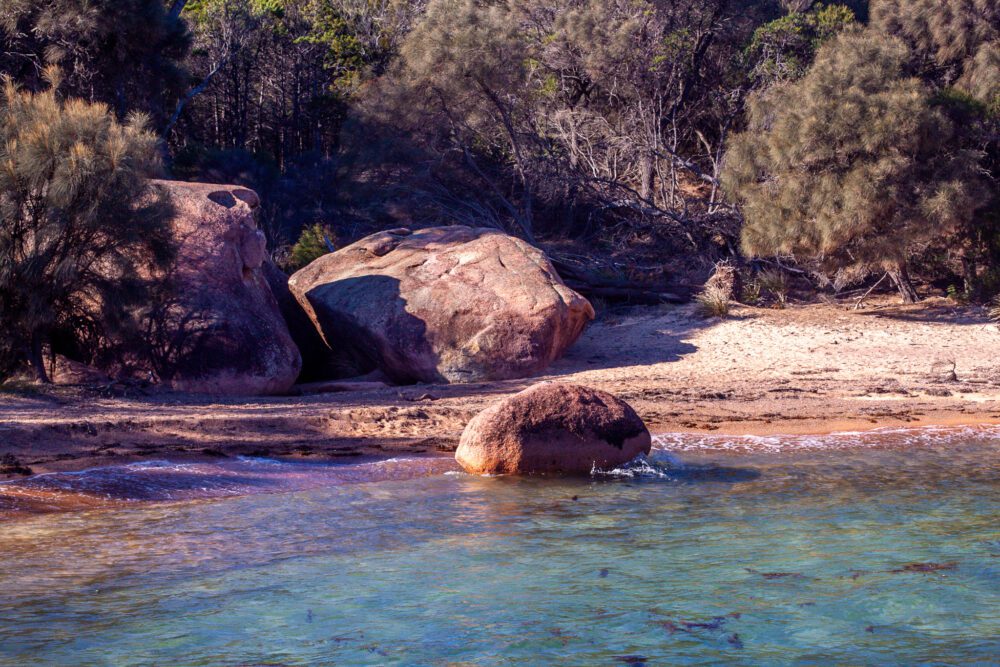
There is a tiny little beach here, protected by rocks on both sides of the bay with crystal clear waters.
Access is just a short walk in from the car park and this little spot is so peaceful if you are lucky enough to find yourself here without any other tourists around!
Again, foiled by only bringing my 50mm lens, I couldn’t get all the bay into one shot, don’t make my mistake!
Walk out the rocks, and you might be surprised at how rough the waves are outside the bay compared to how calm they are inside.
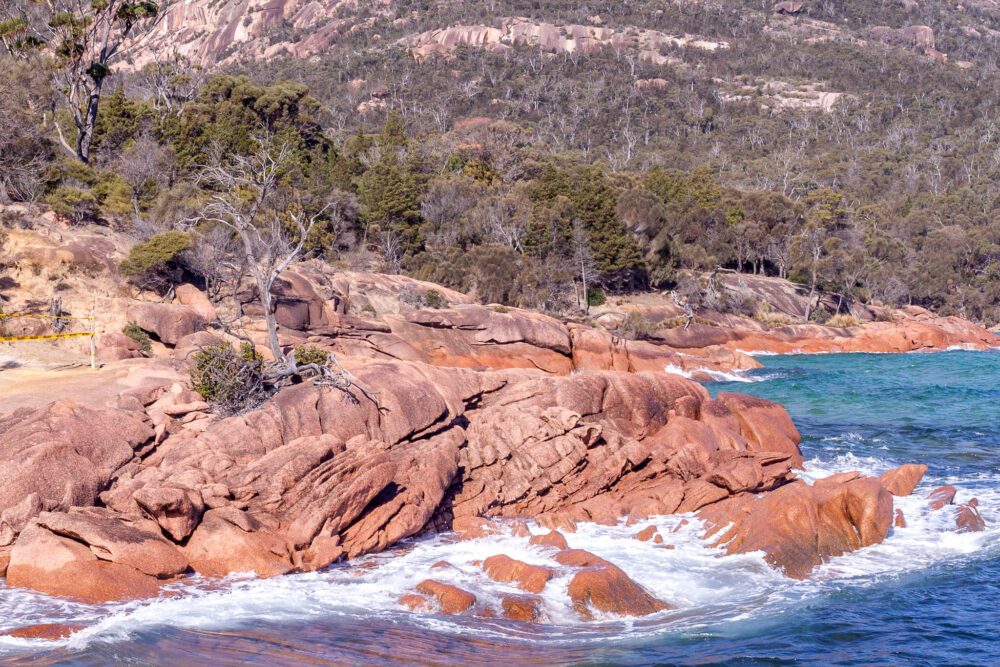
Cape Tourville Lighthouse and Lookout
Next up in Freycinet National Park is Cape Tourville.
It’s a 5.5km drive from Honeymoon Bay that takes us from the peninsula’s west side to the east.
The drive takes around 10 minutes, and at the end of it, you’ll find the Cape Tourville Lighthouse and Lookout.
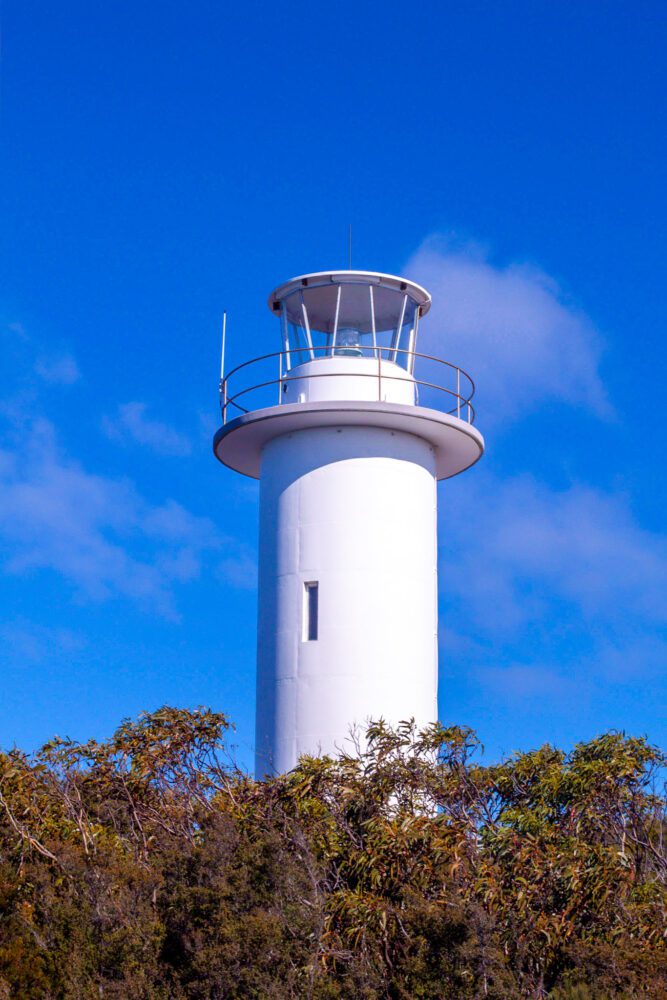
Cape Tourville Lighthouse was built as an unmanned lighthouse in 1971, and the excellent 600m boardwalk around the cliffs at Cape Tourville provides fantastic views out to the ocean and to the south.

Looking carefully, you can see straight down Wineglass Bay to the beach, giving a different perspective to the bay and beach we saw earlier in the day.
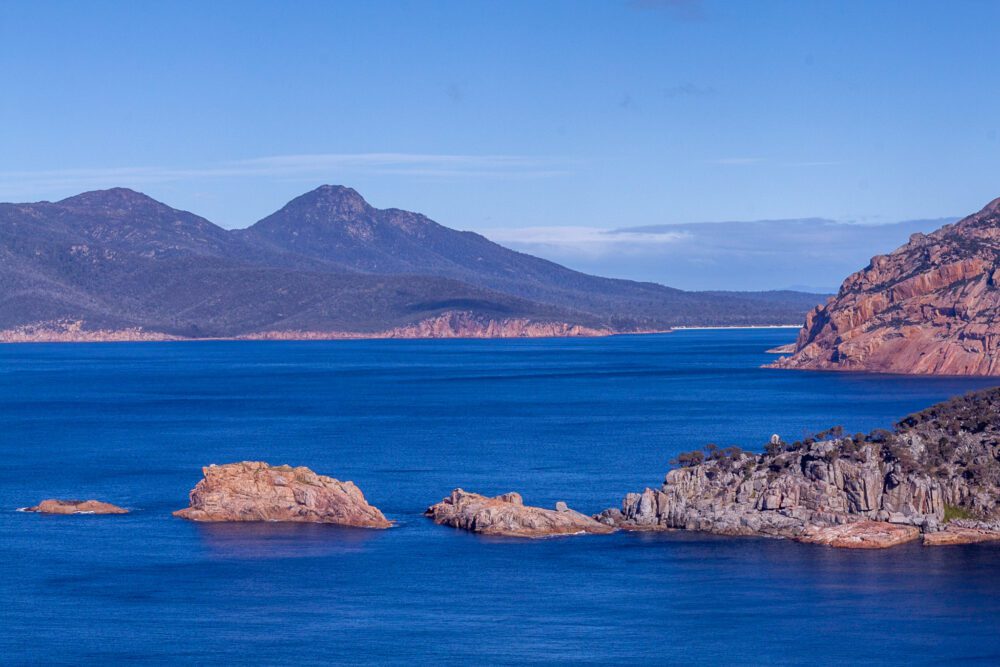
Also to the south is Lemon Rock, and to the north you can see the Nuggets, a group of four granite islets that are home to many species of breeding birds, including the blue penguin (also known as the little penguin).
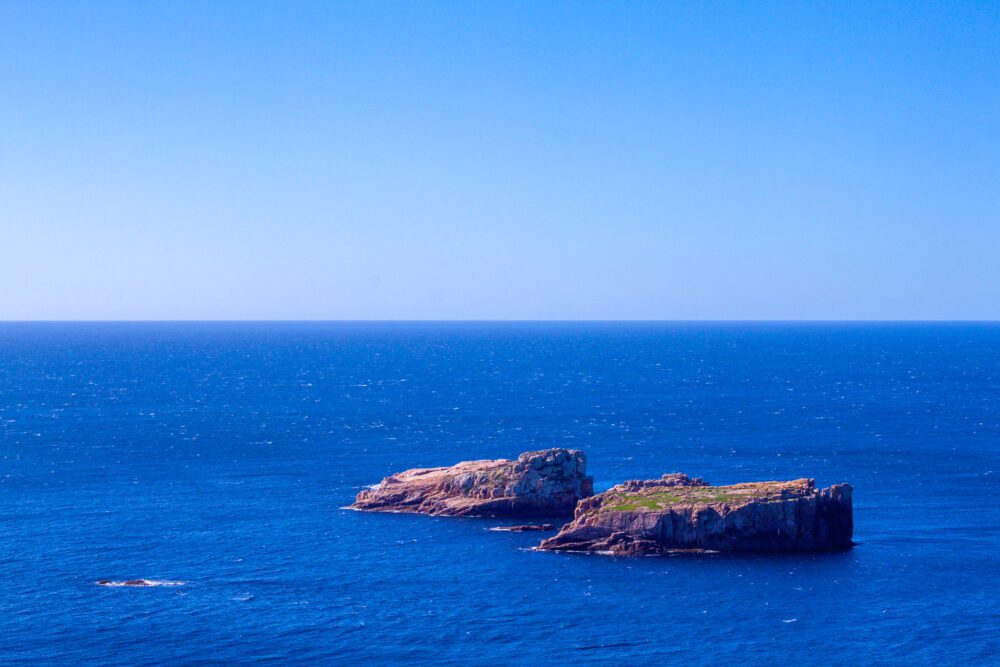
From the Cape Tourville lookout, it looks like only two islets, but you can just make out a third. The fourth one is hidden behind the others from this angle.
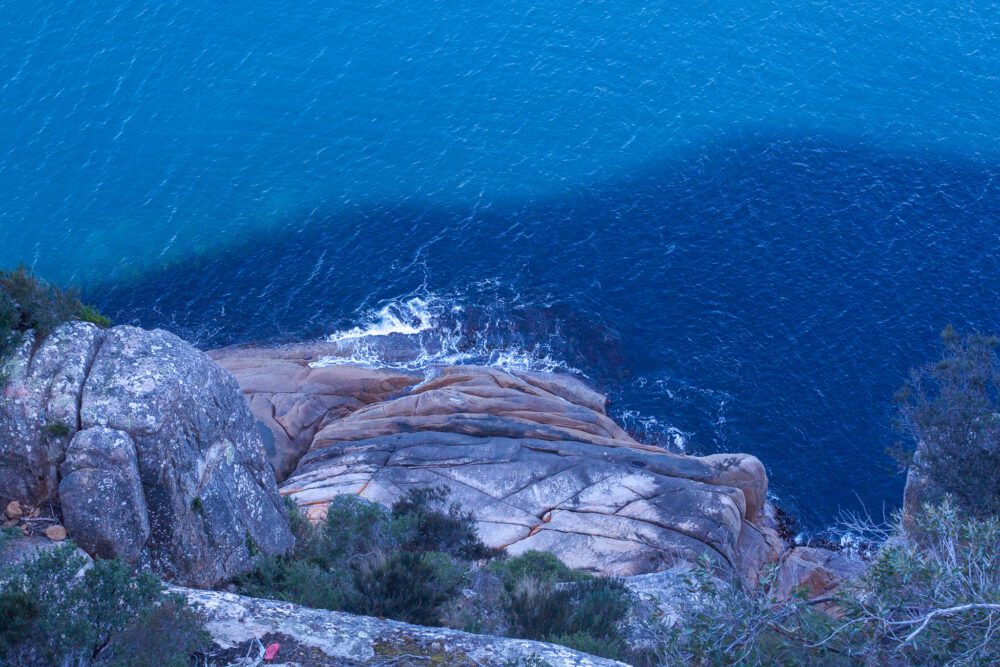
Don’t forget to look down while you are taking in the view. There are a number of species of skinks that are native to the cape, chances are good you will see at least one along the path!
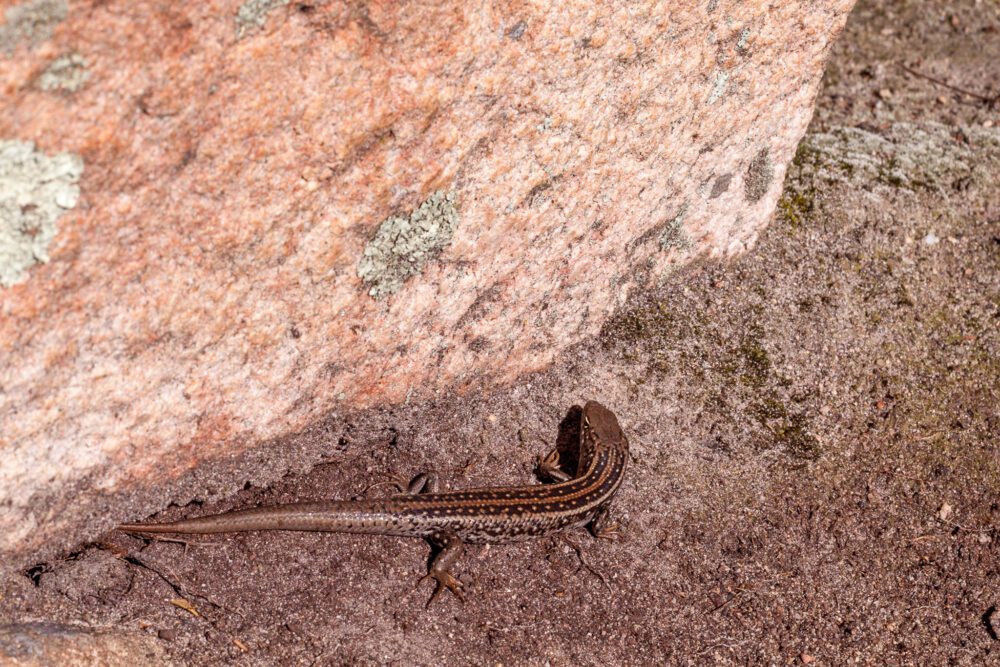
Bicheno Blowhole
From Cape Tourville, the next stop is Bicheno.
Bicheno Blowhole is 45km from Cape Tourville and is about a 45-minute drive.
At Bicheno, you are now also closer to Launceston than Hobart!
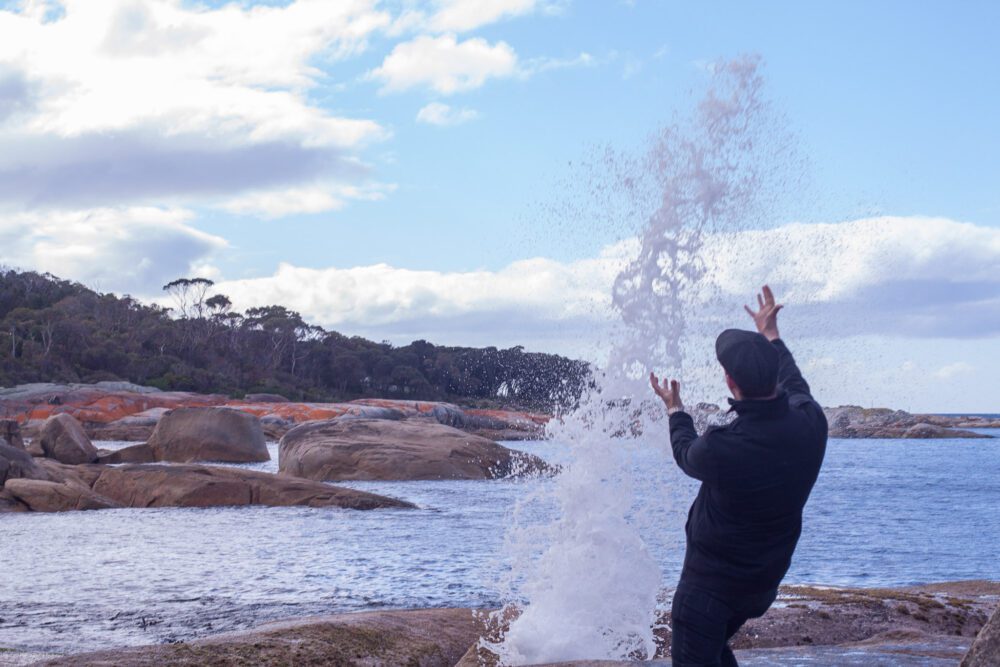
The Bicheno Blowhole is a solidly predictable blowhole where waves are forced up through granite rocks at the southern end of the town.
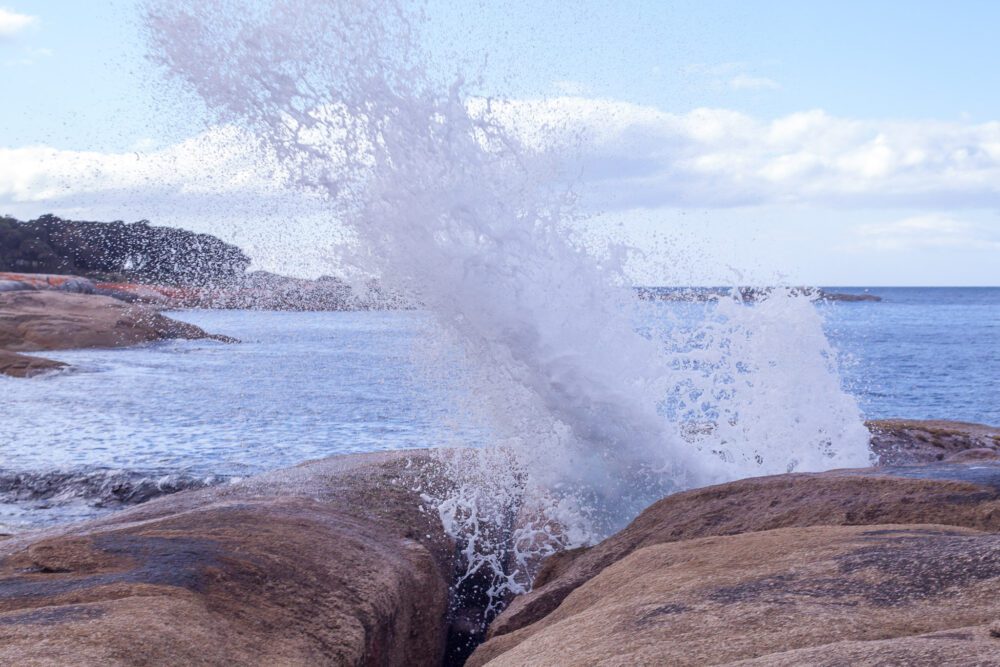
This blowhole can be quite impressive if you have strong and frequent waves come through. However, it’s very regular regardless, blowing every minute we were there.
Grab some afternoon tea – or dinner, and then head back to Hobart.
For us, our flight headed home at the end of this day, so we had to get back to the airport before too late!
And that’s it!
¿Qué más?
There is a lot more to see and do in and around Hobart. The capital city of Tasmania is home to so much history and natural beauty abounds in the region. It doesn’t take long to drive from one end of Tasmania to the other, but you can spend far more time here, if you have the time.
Been to Hobart already? What was your favourite thing? Let me know in the comments!

